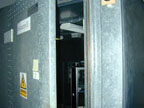June 19, 2007
Avatar Machine
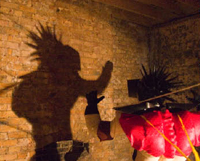
Virtual Reversal
"The virtual communities created by online games have provided us with a new medium for social interaction and communication. Avatar Machine is a system which replicates the aesthetics and visuals of third person gaming, allowing the user to view themselves as a virtual character in real space via a head mounted interface. The system potentially allows for a diminished sense of social responsibility, and could lead the user to demonstrate behaviours normally reserved for the gaming environment."
That was the blurb i read on the website of Charming Disaster, an exhibition featuring several works created by students of the Royal College of Art’s Design Products department (thanks Noam for telling me about it!) What i like about Avatar Machine is that, like the One Eye Ball but unlike several similar projects i've blogged in the past, it's not just about coming up with a nice, funky, geeky project before everybody else, it is also a very eye-pleasing work. I love the way that the designer pushed the concept further by making the user wear the costume of an avatar, i imagine that it allows observers to participate (albeit in a much more discreet way) to the experience. So i asked design student Marc Owens to tell me more about the work.
How does it work technically?
The system works in a very simple way. The user wears a body harness, which has three 2m long aluminium rods protruding from it, to form a type of tripod. A wide angle pinhole camera exists at the point where all three rods meet. The camera is pointing directly back at the user. The video footage being recorded by the camera is transmited to the monitor inside the headset so it can be viewed by the user. Therefore the user can see themselves in the third person, from head to toe on the monitor interface.
It is WoW that inspired the kind of costume that the player has to wear in your installation, did i get that right? Any reason why you chose to refer to WoW?
You are correct in thinking that the project is World of Warcraft inspired. As the worlds most popular online game, the asthetics and characters of WOW are the most easily recognisable, also i wanted the character i created through the costume be be large in stature, so the user could experience a sense in invincibility when controlling the avatar on the interface. Also, WOW, is more classically fantasy based than other MMORPGs, like second life for example, so that is an element i wanted to bring into the experience of the product.
Thirdly, i am ashamed to admit, quite a fan of World of Warcraft!
Which kind of behaviour did you observe when visitors of the Charming Disaster were playing with your work?
At the Charming Disaster show a few weeks ago, the screen within the headset burned out after an hour into the performance. So only one or two people had the opportunity to experience the system. However since then, i have carried out some avatar sessions in Hyde Park, allowing ample room for the user to do as they wish, and behave as they like.
The types of behaviour i observed were all quite similar. That being, everyone was quite cautious with their movements to begin with, moving around with baby steps as they slowly got used to controling their movement from the third person perspective. After a few minutes, users began to gain confidence not only with faster and more fluid movement, but also began to mimic the types on movement that they imagined the avatar would demonstrate, ie: stoping around and swinging of arms. Another element to the type of behaviour i observed was that after getting used to using the system, users felt comfortable enough to approach passing 'humans' and observed their reaction through the interface.
All images courtesy of Marc Owens. [blogged by Regine on we-make-money-not-art]
Posted by jo at 08:31 AM | Comments (0)
June 11, 2007
Telematic Dress
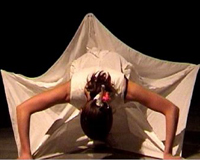
Distributed Proprioception
Abstract: Centered around several short films from streaming performances created in 2005, this paper explores new ideas for movement technologies and garment design in an arts and digital research context. The "telematic dress" project, developed at the DAP Lab in Nottingham, involves transdisciplinary intersections between fashion and live performance, interactive system architecture, electronic textiles, wearable technologies, choreography, and anthropology.
The concept on an evolving garment design that is materialized (moved) in live performance originates from DAP Lab's experimentation with telematics and distributed media addressing "connective tissues" through a study of perception/proprioception in the wearer (tactile sensory processing) and the dancer / designer / viewer relationship. This study is conducted as cross-cultural communication with online performance partners in Europe, the US, Brazil and Japan. The inter-active space is predicated on transcultural questions: how does the movement with an evolving design and wearable interactive sensors travel, how does movement - and capturing of movement - allow the design to emerge toward a garment statement, and how are bodies-in-relation-to sensory fabrics affected by the multidimensional kinesthetics of a media-rich, responsive environment." From The Telematic Dress: Evolving garments and distributed proprioception in streaming media and fashion performance by Johannes Birringer and Michèle Danjoux. [via]
Posted by jo at 05:32 PM | Comments (0)
May 29, 2007
Reconfigurable Costume
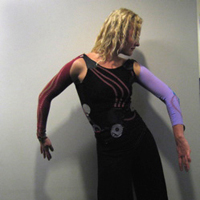
A Platform for Interactive Performance
Leah Buechley's reconfigurable costume consists of a torso piece and an assortment of sensing appendages that can be snapped to the torso. Sensors in the appendages include muscle flex sensors, accelerometers, bend sensors and touch sensors. Sensor data is relayed to a computer, via a bluetooth module embedded in the torso, where it can be used to control or generate music, video and other multimedia content.
The costume, built using her version 2.0 e-textile construction kit, is form-fitting and stretchy. The electronic modules are kept as small as possible so they do not interfere with the dancer. The costume was used in an improvisational performance in May, 2007 to control a player piano. This performance was a collaboration with Michael Theodore, a professor in the music department, and Nicole Predki, a graduate student in the dance department. Click here for a movie (150MB).
Posted by jo at 06:37 PM | Comments (0)
May 22, 2007
Walking City: Pneumatic Dress
By Ying Gao, part of “Indice de l’indiférence: Walking City” at Galerie Diagonale, 5455, de Gaspé street, space 203 :: May 29 to June 9.
Posted by jo at 02:53 PM | Comments (0)
January 18, 2007
Schwelle
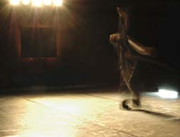
@ Tesla/Transmediale 2007
Schwelle is a new media and performance project using cutting edge acoustic and interactive technologies to explore the extreme threshold states of consciousness that constitute human experience. The multi-part project uses High Definition image and multi-channel sound, interactive installation and live performance to create states of consciousness in the spectator akin to the thresholds states that one experiences at the edge of trance, sleep and death. For transmediale '07, Tesla presents parts 1 and 2.
Part 1 is a turbulent exploration told by way of image and sound of the experience undergone at the time of the dissolution of the body and of consciousness. Part 2 is a live performance in which the audience confronts a lone single performer Michael Schumacher, master improviser and long time dancer by William Forsythe’s Frankfurt Ballet, experiencing the traumatic transition period between death and rebirth. Utilizing wireless sensor networks in the room and on the dancer’s body, Part 2 creates a stage environment where light, sound and objects take on their own choreography, performing with Schumacher, breathing, and behaving alongside him. Where does the body end and the room begin? What happens in the threshold where body and room merge, mutually influencing and transforming each other?
Schwelle is a co-production between artists and researchers from cultural and scientific institutions in Canada, China, Germany, Holland, China, and the USA. Schwelle, Part 2 was partially developed during a project residency at Tesla in Summer 2006 and will receive its world premiere at "tesla zur transmediale".
Part I
Concept/Direction/HD Video/Sound: Chris Salter
Collaboration Sound: Daniel Moody-Grigsby and Philip Viel
Part II
Premiere: Tesla/Transmediale 2007, Berlin, February 2007
Concept/Direction: Chris Salter, in collaboration with Michael Schumacher
Dramaturgy: Heidi Gilpin
Lighting Design: Lea Xiao
Sound Design and Programming: Marije Baalman, Daniel Moody- Grigsby, Chris
Salter, Philip Viel
Interaction Design/Sensing Systems: Marije Baalman
Objects: Thomas Spier, Flora Luna
Production Stage Manager/Technical Director: Daniel Plewe
Production Assistents: Daniel Wessolek, Alexander Wilson, Brett Bergmann
Tesla: Medien-Kunst-Labor, Klosterstrasse 68, Berlin
Thursday-Saturday, February 1-3, 2007. 20:30
For tickets/more information, please visit http://kasse@tesla-berlin.de
Christopher L. Salter, Ph.D.
Asst. Professor of Computation Arts
Faculty of Fine Arts
Concordia University
Researcher_Interactive Performance and Sound Hexagram
Posted by jo at 03:00 PM | Comments (0)
January 11, 2007
InSense: Interest-based life logging
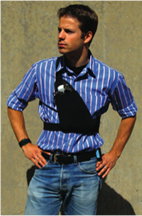
Mapping First Life Experiences with Virtual World Counterparts
Blum, M. Pentland, A. Troster, G. (2006), InSense: Interest-Based Life Logging, IEEE Multimedia, 13 (4), pp. 40- 48.
The paper describes a wearable data collection device called InSense based on Vannevar Bush’s Memex principles. allows users to continually collect their interactions as store them as a multimedia diary. It basically take into account the sensor readings from a camera, microphone, and accelerometers. The point is to “classify the users activities and “automatically collect multimedia clips when the user is in an “interesting” situation“.
What is interesting is the types of categories they picked-up to develop their context-aware framework: they chose location, speech, posture, and activities—to represent many diverse aspects of a user’s context. They also have subcategories (for instance for location: office, home, outdoors, indoors, restaurant, car, street, shop).
The experience sampling approach works like that:
Subjects wear the system for several hours without interacting with it. Audio and acceleration signals are recorded continuously. The camera takes pictures once a minute and WiFi access points are logged to establish location. After the recording session, the user employs an offline annotation tool, which presents an image at a time, the corresponding sound clip, and a list of labels from which to chooseshowing sensor placement.
What is also curious is their description of their algorithm that calculates the current level of interest of an event based on the context classification.
Why do I blog this? I am less interested in the purpose of the system itself (sharing material) but rather by the data extracted from context readings and how this could be used to tell a story (or to build up a narrative). Of course, given my interest in games, I see this device as intriguing and potentially relevant to map the first life experience with virtual worlds counterparts; it could go beyond current pedometer that control dogs. [blogged by Nicolas on pasta and vinegar]
Posted by jo at 02:34 PM | Comments (0)
December 29, 2006
A frock with a mind of its own
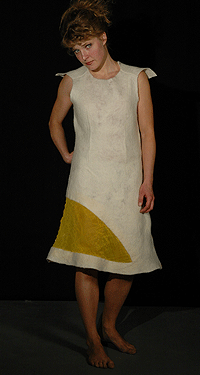
Surrendering Control
A dress with animated flowers on its neckline, shirt sleeves that make sounds in tune with your body language, and a hemline with a mind of its own have been developed by a Canadian researcher. Professor Joanna Berzowska and international colleagues will discuss these and other examples of ‘wearable technology’ at a workshop in Australia next year called reSkin.
Berzowska’s flowery dress, named Kukkia, has a neckline with felt and silk flowers that open and close according to a special electronics embedded in the dress. “I really wanted to make these dresses that have personalities, that move and behave almost like animals,” says Berzowska, who teaches computation art at Concordia University in Montreal.
The flower petals are made of silk and felt, and contain thin wires of Nitinol, an alloy of nickel and titanium. Nitinol is a ’shape memory alloy’, which can be programmed to have different shapes at different temperatures.
When the wire heats it shrinks and pulls the petals together, closing the flower. As it cools down, the wire relaxes and the petals open. A custom electronics board is connected by embroidered conductive thread to the flowers and makes each one open and close every 15 seconds. The system is run on rechargeable lithium polymer batteries, originally designed for use in model aeroplanes, which are embedded in pouches in the dress.
Another dress with a mind of its own is Vilkas, which has a hemline that goes up and down on its own. We tend to think of consumer electronics as something we can control. But Berzowska says once you turn on the microcontroller in these dresses, you have to surrender control.
“I like how perverse it is to have a piece of wearable electronics that you can’t control,” she says.
“Perhaps they don’t do what you want them to do and they behave in unexpected ways on your body. Maybe they move at inappropriate times.”
Musical pants and sound sleeves
Berzowska also has musical clothes including musical pants that make a sound every time you take a step. “As you’re walking through public space you can leave a whole trail of sounds behind you based on how you’re walking,” she says. She also has ’sound sleeves’ that produce different sounds to reflect the wearer’s body language.
The sleeves produce a higher frequency sound the harder you squeeze your arms together. If someone is feeling angry or threatened they cross their arms causing the sleeves to generated an almost painfully high pitch. “But when you relax your arms the pitch goes down,” says Berzowska. “It almost sounds like a cat purring.”
Intimate memories
Berzowska has another outfit called Intimate Memory that record acts of physical intimacy using a microphone and a series of light-emitting diodes (LEDs) stitched in a curved line across the front.
The LEDs light up when someone touches the skirt, whispers something in the ear of the wearer, or blows on their neck. “The number of lights represents the intensity of the intimacy event similar to the volume indicator on a stereo,” says Berzowska. “Over time, the lights turn off, one by one, to show time elapsed since the event took place.” [posted by regine on twenty1f]
Posted by jo at 10:52 AM | Comments (0)
December 28, 2006
Mary Mattingly
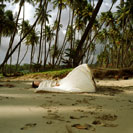
disturbing beauty
... ok, the threat by mobile phones (to which she refers) just recently has been dismissed as no longer relevant, but nevertheless there are interesting relations and a fantastic worldview to be discovered at Mary Mattingly’s project website. [link to Mary Mattingly: Second Nature – a text on M. Mattingly’s photography.]
She developes a scenario which emerges around a ‘disastrous beauty’ according to an imagination where our actual and eventual technological developments are brought together with to-come-ecological changes. It all together impresses through the beautiful set-up and the quite carefully lay-out of a world to be – combined with changes already happening… Some of her most impressing images relate to the imagination of ‘wearable homes’. In her writings she describes quite clearly the process of thought and procedure of her project development:
In the design of the Wearable Home, I examine the cohesive threads of cultures’ and groups’ clothing throughout the world; from Inuit cultures to saris in India, Muslim, Hindu, Zen Buddhist garments, American Gap, Banana Republic, the Khaki Overcoat, muslin design prototypes, construction uniforms, kimonos, Dockers, safari camouflage, military uniforms, the blandification and brandification of garments spanning cultures worldwide to make one, general look de-emphasizing self and re-emphasizing everything else (collaboration, ideas, survival, modularity, etc.). I think this, over time, is a creative way to think about the outcome of mega-mergers and the illusion of choice, technology and the idea of utopia, as well as wiki-run systems. The result, then, may be that one wearer would be indistinguishable from the other, thus greatly alleviating the threat of the end of privacy. Our distinguishing features would be greatly masked in this context to the naked eye, however the pervasiveness and scrutiny of high-powered networks would still catalog our movements and whereabouts. (link) [blogged by mo on mind the _GAP*?)
Posted by jo at 08:21 AM | Comments (0)
December 06, 2006
Anne Galloway
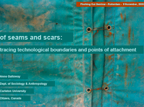
Fleshing out, finally
I've finally gotten around to annotating my presentation from Fleshing Out in Rotterdam last month: Of seams and scars: Tracing technological boundaries and points of attachment (pdf)
Looking at my notes, I see that it conveys some of the breathlessness with which I delivered my presentation, and I'm not sure that's a good thing. But I think there are some good ideas here, and I'm very grateful that I've been given the opportunity to further explore them for another conference in the spring. Anyway, I've received quite a bit of email that I'd like to briefly address by means of an introduction to the content. My presentation was about metaphor and materiality in "wearable interfaces, smart materials and living fabrics." My focus on scars completely ignored literature on the grotesque, although I was particularly interested in what scars actually mark. This is something I'll have to look into more. My focus on seams extended current approaches to ubicomp design by Matthew Chalmers and others by explicitly engaging the political and the ethical. So rather than just focussing on making technological infrastructure more visible, I wanted to start thinking about what kind of "infrastructure" we were talking about, and what kinds of politics and ethics that allowed. My presentation traces my early thinking along these lines and offers questions for further research. As always, comments and questions are welcome.
Posted by jo at 05:05 PM | Comments (0)
November 25, 2006
The Fruit Fly Farm
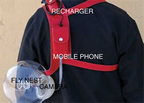
Wearable Sculpture
With The Fruit Fly Farm sculpture, Laura Beloff is investigating both technological society and organic (insect) society. The Fruit Fly Farm is built as a wearable object for people to adopt and carry around. It is a personal “pet” and wearable system with a public access via mobile phone. A camera phone, embedded in the sculpture, is observing the fly community. Anyone can access the phone camera by sending a sms to the piece. The camphone will then capture an image and send it back as an MMS. The photo along with the sms-messages (comments) will also be uploaded to a dedicated website.
The fly nest is located in the middle of the Ø20cm transparent acryl ball. The nest capsule contains rotten fruits and needs to be re-filled approximately once a week. Small holes allow the flies to fly in and out of the nest. Until November 30th 2006, you can send the sms to this number: +47 92096767 (Norway). In the same series of “wearable” future works which address the society and surrounding environment as the their theme: The Head. [blogged by Regine on we-make-money-not-art]
Posted by jo at 08:58 AM | Comments (0)
November 14, 2006
Regine Debatty's

Interview with Lalya Gaye
I've been writing about Lalya Gaye's work over and over again ever since i started to blog. She's one of those few people who seem to swim effortlessly in both the artistic and the purely scientific waters.
She's an engineer and PhD graduate working in multidisciplinary projects that search to explore new territories of personal expression and creativity enabled by ubiquitous computing. Her research focuses on mobile media for urban space and on computational repurposing of everyday objects. In 2002, she started working on various research projects at Future Applications Lab, Viktoria Institute in Göteborg, Sweden. But she still manages to find some time to develop smaller new media projects with friends and to get involved in the mobile music and New Interfaces for Musical Expression (NIME) communities... More >>
Posted by jo at 09:19 AM | Comments (0)
Volume Over Lumen
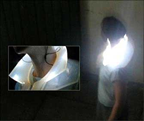
Rhythm Communicator
Volume Over Lumen is a rhythm communicator for several people. Each participant wears a silicone collar which sends a rhythmically arranged sound. A particular sound is generated for each participant according to an analysis of their voice. LEDs in the collar create a halo of pulsating light that radiates around the wearer. If another partecipant comes within the range of the collar, he or she can hear the sound generated by the collar worn by the first person. But if he or she comes within the range of several collars, then it’s a mix of the various sound compositions that will be heard.
By their own movement in the area participants can modulate their own sound experience, as well as the acoustic experience of the other collar wearers. Electronics are visibly cast in the collar: resistances, transistors, diodes, conductive strips and other elements have a functional as well as an aesthetic role. A work by Martin Bellardi and Anne-Christin Delakowitz. [blogged by Regine on TWENTY1F]
Posted by jo at 09:13 AM | Comments (0)
November 13, 2006
WIS
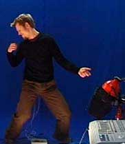
The Wearable Instrument Shirt
Scientists at the CSIRO's Textile and Fibre Technology division in Australia have woven electronic sensors into a T-shirt (the WIS - the Wearable Instrument Shirt) so that it can be played liked a real guitar. Movements by the wearer's arms are mapped and beamed by radio to a computer which interprets them and turns them into musical notes.
"The left arm chooses a note and the right arm plays it," said Richard Helmer, at CSIRO. The arrangement can be reversed for left-handed musicians. "You can play with yours hands above your head," added Dr Helmer. "You can turn around and jump. Whatever you like."
Video of the shirt + tambourine and guiro versions of the shirt. Via SMH. Similar but with added orange gloves: The Virtual Air Guitar. Also Facial Control for Electric Guitar; GuitarBot, a self-playing guitar; Bangarama to play guitar just by banging your head up and down. [blogged by Regine on we-make-money-not-art]
Posted by jo at 10:11 AM | Comments (0)
October 24, 2006
Make your own Wearable Workshop

smart clothing for smart users
Make your own Wearable Workshop
smart clothing for smart users
10November2006>12November2006
Amsterdam, Mediamatic
Oosterdokskade 5
Amsterdam
T 020 638 9901
www.mediamatic.net
10:00 hr, from 10.11.06 t/m 12.11.06
Tiny chips, cheap sensors and the possibilities of emerging smart fabrics, conductive yarns and cheap wireless communication (bluetooth or even rfid) make wearables easier and cheaper to make. Arduino boards are small physical computing platforms: Arduino developed a fairly simple integrated development environment to deal with the small portable input/output board. With all these tools at our fingertips, nothing is stopping us from making our own smart coats, reactive hats and luminescent skirts.
To help you get started, Mediamatic is organizing a wearables workshop where you can develop your own Arduino-driven wearable. Assisted by Massimo Banzi, one of the creators of the Arduino board and several coding/soldering/sewing helpers, you have three days to make your prototype in the stimulating surroundings of the Mediamatic Winter Garden.
What?
During the workshop, you will design your own wearable. You will define the sensor inputs and the actuator outputs. You will program the Arduino board to react correctly to the different inputs. You will do this in Arduino's own IDE, which helps you write a kind of simplified Java code similar to Processing. Then you will stitch/glue/felt together your prototype so you can participate in the wearables fashion show!
Who?
Computer scientists, fashion designers, hardware hackers, art students, fabric experts, product developers, dancers- everyone is welcome. However, note that some technical affinity is required. Some experience in programming and electronics is useful, specifically in soldering and java, but not strictly necessary. We would advice participants to come in teams of max. 3 people, so you can distribute soldering, coding and sewing tasks.
Where?
The workshop will take place in the latest Mediamatic exhibition: the Winter Garden. The Winter Garden is an indoor botanical garden filled with plants and robots. From the minimalistic electronic creatures of Ralf Schreiber to the virtual forest of Michiel Samyn to the interactive plant by Christa Sommerer and
Laurent Mignonneau to the pheromone tinged garden benches of Mateusz Herczka and the communicative crickets of Felix Hess- the Winter Garden is full of wonders.
What to bring?
If there is a specific sensor or actuator you would like to use during the workshop, we advise you to bring it yourself. You can also bring the actual clothing article beforehand, and not sew it during the workshop, or you can bring fabric and other material for the base of your wearable. You'll have to bring your own laptop to do your coding, and we advise you to download the Arduino software and have a look at it beforehand. Also, bring lunch.
How to prepare?
Besides looking at the Arduino software you can have a look at the Mediamatic wearables reader - a collection of interesting articles, websites and blogposts that can get you started in the world of wearables. Virtual Platform and V2 are organizing a wearables symposium in Rotterdam called Fleshing Out the day before the Mediamatic Arduino workshop with speakers such as Ionat Zurr (SymbioticA: the art and science collaborative research laboratory), Tobie Kerridge (Royal College of Art, London) and Joanna Berzowska (Design and Computation Arts , Concordia University, Montreal).
When?
The Fleshing Out Symposium is on Thursday November 9th at V2. The Mediamatic Arduino Wearables Workshop is from Friday November 10th to Sunday November 12th. The Kiem Cuisine Wearables dinner is Friday at 19:30 at Mediamatic. The Wearables fashion show is Sunday evening at 18:00.
Costs?
The Fleshing out symposium costs 40 euros. Students receive a discount of 20 euros. The Wearable Arduino workshop costs 125 euros. Dutch students receive a discount of 50 euros.
register at www.mediamatic.net/workshopregistration
Posted by luis at 08:49 AM | Comments (0)
October 19, 2006
Net_Dérive
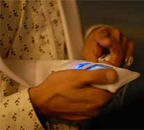
The City as Instrument
Net_Dérive, by Atau Tanaka and Petra Gemeinboeck with the collaboration of Ali Momeni, is a location sensitive mobile media art piece that calls for an exchange between participants in the gallery and participants in the streets. Deployed on advanced mobile phones, the work seeks to create a kind of musical instrument, thinking of the city-as-instrument.
Participants are given a kind of scarf with a mobile phone in each end and off they go to explore the neighborhood. One of the phones takes pictures every 20 secs and collects sounds, the other talks to the GPS (also in the scarf) and to the server inside the gallery space. On a radar they can see themselves pictured as dots but also the images they're taking. The sounds and pictures collected in the streets are sampled and mapped to a 3D city map in the gallery. As users are walking they can hear some voice instructions through a pair of headphones. Those comments suggest paths to follow or turns to make, they are generated and heard in a musical fashion. The voice instructions are inspired by the old Situationist games and theory of the Dérive - now brought into the digital and mobile spheres. As the user chooses to heed or ignore these instructions, a trace of his/her path is carved out in the city.
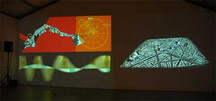
The engine then generates an audiovisual amalgam based on this information, and feeds it back as a live stream to each mobile client. The simultaneity, history, and memory of the various users’ paths and images become an abstract narrative that is summed together and projected in the gallery space. A feedback mechanism is created as users’ actions generate the collective narrative that in turn directs them.
Presented in Paris during the IntensiveScience exhibition of Sony CSL Paris, 6, 7-october 2006
Photos by Walter Kim. Images and information courtesy of Atau Tanaka.
Related: Sonic City, a wearable piece that enables people to compose music in real time by walking through the city; headphones that turn urban noise into music. Atau Tanaka's talk at Futuresonic; Pixel bondage on rice paper. [blogged by Regine on we-make-money-not-art]
Posted by jo at 08:38 AM | Comments (0)
October 17, 2006
undersound + unspoken_series

Interactions Under the City
undersound is an interface that allows you to listen to, distribute and affect the flow of music on your mobile phone while you're travelling in the underground.
The project imagines that you will be able to add music to the system at upload points in the ticket halls, and download tracks on the platforms. Because of the architectural configuration of the stations undersound users would have to congregate at certain locations for the purpose of interacting with the system.
Each track in the system is tagged with its place of origin (the station where it was uploaded) and this information is visible as the track is being played. This may trigger musings around your personal relationship to that place.
While in the carriages of the tube, you can browse undersound music of other people in range (that idea was inspired by tunA). You can see when a track has been in the system, the number of times it has been played, the number of people who have played it, etc. You can browse through other's tracks anonymously, but if you decide to download a song from someone else an alert will be triggered on their phone letting them know that you are grabbing one of their tracks.
A project by Arianna Bassoli, Johanna Brewer and Karen Martin.
Via coin-operated.
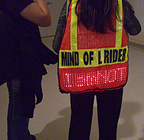
Another nice art project for the metro:
In unspoken_series, performers done a custom-made construction vest embedded with red and green LEDs to permit the display of up to 24 characters.
The artist programmes messages on the front and back of the vest, revealing facts, thoughts or ideas that the wearer would otherwise not pronounce in public. For example, the vests worn in the metro could display at once humorous and confrontational messages such as: “Took my seat...I am not happy!” or in an art gallery it could be "This is crap! ...are you happy?”
People who happen to be in the metro become the audience. The vests become the starting point of conversations about issues around the specific city the wearer is traveling to or from, about the main target audience he or she is exposed to, and general concerns in public space.
A work by Hoyun Son whose website also features a very funny parody of Speech Recognition Technology (video).
Currently on view at Sartorial Flux, a show curated by Valerie LaMontagne, at the A + D Gallery in Chicago until October 21st.
Deeper under the ground: For sale: Britain’s underground city; Tokyo's underground farm; Frame-by-frame underground ads; Cast Off stages knit-ins on the London Underground, occupying a carriage and knitting around the Circle line; Locker art show; parasite and Chiho Aoshima in the London underground. [blogged by Regine on we-make-money-not-art]
Posted by jo at 11:56 AM | Comments (0)
September 29, 2006
Perimeters, Boundaries, and Borders
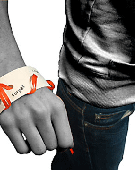
Prototyping the Perimeters
Artists, architects, designers, and other practitioners are constantly fashioning new forms and challenging disciplinary boundaries as they employ techniques such as rapid prototyping and generative processes. In the exhibition Perimeters, Boundaries, and Borders, at Lancaster, UK's Citylab, organizers Fast-uk and Folly explore the range of objects, buildings, and products being conceptualized with the aid of digital technologies. Aoife Ludlow's 'Remember to Forget?' is a series of jewelry designs that envisioned accessories incorporating RFID tags that allow the wearer to record information and emotions associated with those special items that we put on daily. Tavs Jorgensen uses a data glove in his 'Motion in Form' project. After gesturing around an object, data collected by the glove is given physical shape using CNC (Computer Numerical Control) milling, creating representations of the movements in materials such as glass or ceramics. Addressing traces of a different sort is Cylcone.soc, a data mapping piece by Gavin Bailey and Tom Corby. These works and many more examples from the frontiers of art and design are on view until October 21st." Rhizome News.
Posted by jo at 10:59 AM | Comments (0)
September 26, 2006
ANAT Wearables Media Lab

reSkin
New facilitators confirmed for ANAT Wearables Media Lab January 15 - February 4, 2007 :: Australian National University, Canberra :: SUSAN COHN (Australia), NIKITA PASHENKOV (USA), CINNAMON LEE (Australia) and STEPHEN BARRASS (Australia) have been confirmed as facilitators for the reSkin Media Lab, to be held in Canberra, January 2007. They join the previously announced team of renowned media artists ELISE CO (USA), JOANNA BERZOWSKA (Canada) and ALISTAIR RIDDELL (Australia).
Facilitators will be working with artists to research, develop and rapid prototype sensor, time based and reactive clothing, jewellery, shoes, bags, personal environmental and device designs - anything wearable and technologically integrated. ANAT has a limited number of scholarships for participants and funding is also available through the state based arts funding bodies.
About reSkin: reSkin is an intensive three-week workshop focussing on wearable technology, embracing the skill-based practices of object, jewellery, fashion design and media art. The Lab will focus on research and development, experimentation, collaboration and project development.
How to Apply: reSkin is open to Australian and International artists and designers with at least 3 years of practice in the fields of jewellery and object design, textile design, fashion design, media arts, hybrid art and other related disciplines. Application guidelines including further details on the Lab, facilitators, and public outcomes can be downloaded from the reSkin website.
Applications close Monday 9th October.
SUSAN COHN is an internationally known goldsmith and designer who has exhibited extensively and is represented in all major Australian gallery collections. Her many accomplishments include being the first Australian to have a product manufactured by Alessi. In 2001-2003 the National Gallery of Australia celebrated her work with a touring survey exhibition.
Born in the former Soviet Union, NIKITA PASHENKOV has lived in the USA since 1991, where he earnt degrees from Princeton and MIT. He worked with the Aesthetics & Computations Group in the MIT Media Laboratory before moving to live in Tokyo for 2 years where he won the 2001 Tokyo TDC Award for Interactive Design. Nikita's work investigates the intersections between design, programming and electronics technology and has featured in exhibitions at MoMA (New York), Institute of Contemporary Art (London), Eyebeam (New York) and Ginza Gallery (Tokyo).
The work of metalsmith CINNAMON LEE focuses on the relationship between the body and object through interaction. She uses a range of traditional skills and new processes, most recently working with electric illumination and rapid prototyping.
STEPHEN BARRASS is Associate Professor in the School of Creative Communication and co-Director of the Sonic Communications Research Group at the University of Canberra. His artistic works include animated couches, haptic poems, edible soundscapes, virtual opshops, symphonic sculptures and a brain concert.
Further information:
Alexandra Gillespie
Project Manager reSkin
ANAT Media Arts Lab 2006
Email: alexandra[at]anat.org.au
Melinda Rackham
ANAT Executive Director
Tel: (08) 8231 9037
Email: melinda[at]anat.org.au
The ANAT New Media Lab 2006 reSkin is supported by the Visual Arts and Craft Strategy, an initiative of the Australian, State and Territory Governments. reSkin project partners are Australian National University School of Art, Centre for New Media Arts (ANU), Australian National Museum and Craft Australia.
Posted by jo at 12:24 PM | Comments (0)
September 15, 2006
Electric Skin
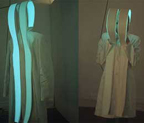
Breath turns to Pulses of Light
Electric Skin, by Suzi Webster -- a MFA student at the Slade Centre of Electronic Media, is a bio-responsive garment that turns the breath of the wearer into pulses of light, acting as a mediating membrane and seeking to create homeostasis between the wearer's internal environment and the external environment. Video. The garment is made of Elumin8 printed LEDs, silk and sensors.
The responsive garment turns the breath of the wearer into pulses of light. The wearer's inhalation and exhalation activate a breath sensor that dims and brightens the printed LED of the garment. The wearer is bathed in the electric aqua light. S/he is connected to the grid by an umbilical cord/power cable, and while this creates a seductive light, it also creates a frisson of danger and unease. Other viewers see the intimate breathing of the wearer as slow pulses of light on the exterior of the garment.
Electric Skin is a hybrid object/performance that questions divisions between ‘subject/object’ ‘inner/outer’ and ‘mind/body’ and creates an experience of that liminal space that is neither inside nor outside, but is a third space inbetween.
Electric Skin will be presented this Friday at the How Smart Are We? symposium the Royal Institute of British Architects.
Related: Scuba, an audio device that allows you to adapt the soundscape from the external environment to your breath; the Kiss COmmunicator, the art of breathing, Breathe on me, the Breath Car. [blogged by Regine on we-make-money-not-art]
Posted by jo at 02:31 PM | Comments (0)
August 24, 2006
The Pong Dress
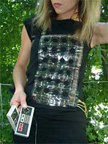
Body as Screen
The little black dress as erotic playground for pong? Max Moswitzer and Margarete Jahrmann alias Marguerite Charmante of the Ludic Society (and of the Nybble Engine fame) have crafted a Pong Dress to dissolute the boundaries between body and screen.
White LED's shine through the black front of the dress. At hip level, two retro-game consoles are offered to players to play Mini-Pong on a 5x7 LED screen worked into the dress. Two pixels move up and down as rackets to the left and right along the waist. With every achieved point, the green score display blinks at chest level.
Hit the dot back and forth with two sticks - this time all new on a 3D playing field, that is moving, chatting and laughing. we hit the dot with some spin from the height of the belly button and aim at the left nipple.
Check it at the Pong Mythos exhibition that just opened in Leipzig. More images.
The dress was inspired by Valie Export's Tap and Touch Cinema, 1968, in which the artist, a box attached to her naked chest, invited pedestrians in several European cities to "visit the cinema".
Via Selectparks. Related: Dress, a polypropylene dress fitted with small "counters" which offer glimpses of human flesh for "sale"; One ball, two bats and our life in a digital world. [blogged by Régine on we-make-money-not-art]
Posted by jo at 02:13 PM | Comments (0)
August 17, 2006
Full Contact Concert

Let's Get Physical
Vollkontaktkonzert - Full Contact Concert, by Stefan Brunner and Michael Wilhelm, arranges a musical composition out of a boxing match. Two performers are equipped with microphones. One microphone, connected to a stethoscope underneath the scapula of the performer’s back, records the repercussion of the beats hitting his chest. The other microphone, glued to the performer’s chin, records his breath.
The sounds are post-processed on the laptop controlled by a third person. The whole piece of music unfolds: the introduction is the warm up. Then the performers put on the boxing gloves and a beat-part begins: performers start beating each other in turns. Two punches to the stomach then one to the chest, two to the stomach, one to the chest, etc. It goes faster and faster until the break, all you can hear is the performers' breath and sounds from the laptop. After they have recoverd from the exhaustion, the boxers start to treat each other with more punches to their chests and stomachs.
The video isn't particularly spectacular but i still like the concept. More images. Via Vvork.

There's a few boxing performances and installations around: Videoboxing, a video performance in which Thomas Heijmans and Eliane Roest merge video, new media, music, fashion, choreography and physical violence on stage; Telephoneboxing (left), by Allard Roeterink, turns the phone call into a hard-work physical process; Soundslam, a highly sensitive punching bag with built-in trainer; Cyclone Uppercut, a boxing game that runs in Virtual Reality Simulators. [blogged by Régine on we-make-money-not-art]
Posted by jo at 07:28 PM | Comments (0)
August 08, 2006
Exploded Monologues
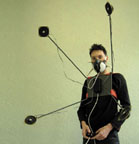
Transcending the Bodies' Boundaries
Exploded Monologues, by Troika, is a wearable machine that allows the user to literally send his voice on one or more of the four different speakers, each of them located approximately one meter from the mouth of the user. A control interface with four different buttons enables the user to choose where his voice will be heard. An additional mask containing a microphone is worn to prevent the listener from hearing the performers voice directly.
Exploded Monologues starts from a reflection on the dialogue through our new technologies of communication and the way they explode the boundaries of our bodies. Exploded Monologues is a performance tool that expands the possibilities of the narrative. The user is able to simulate different characters and play with the sonic space perceived by the listener. [via]
Posted by jo at 12:20 PM | Comments (0)
July 26, 2006
Mouthpiece + Dis-Armor
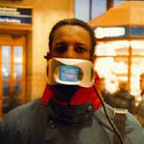
Prosthetic Communication Equipment
The Mouthpiece has been designed to help strangers who find it difficult to express their feelings or opinions face to face. A small LCD monitor and loudspeakers are covering the mouth of the wearer like a gag. The equipment replaces the real act of speech with pre-recorded, edited and electronically perfected statements, questions, answers, stories, etc.
The Mouthpiece "replaces" the actual act of speech with the moving image of the immigrant's lips and the sound of his/her voice. The small size of the screen forces viewers to come closer in order to see the image of speaking lips and to hear the voice clearly, reducing the distance between the immigrant and the other.
The Mouthpiece points to the absurdity of depriving speech rights in a democratic society. It responds to the actual political process and experience of such deprivation, while at the same time it helps to translate this disadvantage into a new advantage. This stranger becomes an expert and a virtuoso in the technology and the artistry of speech, equipped to speak better than others who have yet to overcome speechlessness in their encounter with strangers.
Designed in 1994 by Krzysztof Wodiczko, author of the Homeless Vehicles. The artist also developed Dis-Armor (1999-present), another psychocultural prosthetic equipment designed to meet the communicative need of the alienated, traumatized, and silenced residents of today's cities.
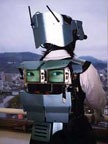
Dis-Armor allows it wearers to speak through their backs. LCD screens on the back display live images of the user's eyes transmitted from cameras installed in the helmet. A speaker amplifies his/her voice. Attached to the helmet is a rearview mirror, alternatively, a rearview video camera, monitor, microphone, and headphone enable the user to see the face and hear the words of who is standing behind. Wireless video equipment further allows two users to work in tandem, showing each other the other's eyes and broadcasting to each the other's voice.
Dis-Armor focus on the psychological difficulties of Japanese high school students and "school refusers," who live in silence and lack facial expression. It uses the ancient traditions of arms making to conceive of a playful alternative to intimidating face-to-face communication. [blogged by Régine on we-make-money-not-art]
Posted by jo at 01:32 PM | Comments (0)
Unravel: the SIGGRAPH2006 Fashion Show
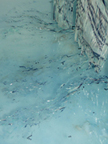
Wonderland - The Disappearing Dress
This project aims through the innovative marriage of art, science, fashion, technology and education to engage public consciousness through more positive currency, through humor, imagination and wonder, both on behalf of the next generation of consumers as well as existing ones. The Disappearing Dress is part of this wider project.
The garment is constructed of a water soluble polymer. When dissolved the fabric turns into a tiny amount of liquid gel which can be reconstituted into a solid once more or used to grow plants. The dress is a dramatic illustration of how the material behaves.
The Disappearing Dress will be at Unravel: the SIGGRAPH2006 Fashion Show on July 31, 2006. In future exhibitions, in London, Sheffield and Belfast in 2007, there will be a series of dresses which will dissolve over the course of 3 weeks and these will be the introduction to the other half of the project - ‘Ideas that can change the world’, practical and inspiring ideas for environmentally sound products and recycling methods.
The Disappearing Dress project is by Prof. Helen Storey of The Helen Storey Foundation; Prof. Tony Ryan of The Polymer Centre at Sheffield University; Patricia Belford and Aoife Ludlow, Interface at University of Ulster. It is funded by the Engineering and Physical Sciences Research Council. More information about Wonderland and Ideas that can change the world is available at:
http://www.helenstoreyfoundation.org
Posted by jo at 10:32 AM | Comments (0)
Unravel: the SIGGRAPH2006 Fashion Show

Garments as Secondary Skins
Unravel: the SIGGRAPH2006 Fashion Show presents a runway show of innovative and experimental works in computational and conceptual couture, fashion with a social agenda, science-inspired form, and new technologies of material fabrication. Unravel brings together the work of designers and artists from the US, Canada, Europe, and Asia who are seeking to redefine the notion of ‘wearable.’
In the increasingly mobile nature of contemporary life, it has become important to contemplate how the devices we carry and the garments we wear converge into a ‘secondary skin’ which function as an extension of ourselves, in both ability and perception. By using fashion, a medium which has always been associated with self-expression and personal identity, these designers seek to demonstrate how the use (or misuse) of technology and its modes of production have the power to stimulate, delight, and inspire in ways as yet untapped in the fashion world.
Gone are the stereotypical bulky cyborg devices; what emerged are garments of beauty, subtlety and elegance in form. Some bring to light important social issues — redefining our notions of personal space, networked environments, and issues of privacy and protection. Others relish in pure delight, reminding us how technology also has the power to enhance our personal relationships and celebrate fantasy and play as part of the human condition.
A few projects:
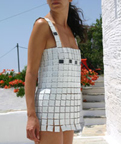
Day For Night (Modular Extensible Reconfigurable) by Studio 5050 - Despina Papadopoulos & Jesse Lackey: Day-for-Night: a dress comprised of 436 white circuit boards that are linked together with metal rings. Each tile is addressable from a central control unit at the back of the dress. Solar cells are embedded on some of the tiles and charge the dress during the day. The dress is completely modular both in hardware, as new tile functionalities can be added and in terms of software. The control unit has an RF receiver module which can receive new programs from a programming USB board with an RF transmitter.
IPV – Clothing System by Adam Whiton (Industrial Designer and Artist) and Yolita Nugent (Apparel Designer): a wearable system designed to intervene in domestic violence situations.
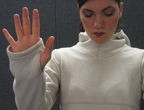
The smart clothing utilizes pressure sensitive fabric to measure impacts to the wearer’s body. The physical abuse data is transmitted to a remote server where it can be archived or distributed to a trusted community or proper authorities. The wearer can chat with their IPV clothing via an artificial intelligence agent that offers them feedback and suggestions based on the received data. This project explores the wearable as a self reflective safe space to assist the abused wearer in reconnecting with social networks. [Also see the No-Contact Jacket]
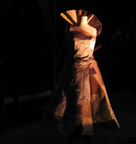
Peau d’Âne by Valérie Lamontagne (Artist and Designer), Lynn Van Gastel (Fashion Design), and Patrice Coulombe (Technical Design): In the Charles Perrault fairy tale “Peau d’Âne” a young princess, whose stepfather’s riches are dependant on his gold excreting donkey, orders the impossible from her doting father in order to avoid having to marry him: three dresses made of immaterial materials: the sun, moon and sky. The aim of the project “Peau d’Âne” is to incarnate these “impossible” dresses in a material form. A weather antenna culls live weather data, which transforms the dresses, reflecting the changing barometric characteristics of sky, moon and sun in real-time. The “Sun” dress is based on changes in the sun. The dress will be constructed with a checkerboard of LEDs (light emitting diodes) set in motion based on UV, solar radiation and sun intensity readings.
Posted by jo at 10:18 AM | Comments (0)
July 24, 2006
Tap-n-bass
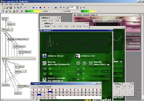
Interactive Dance Technology
Within the field of interactive dance technology, a number of projects have experimented with dancers producing music in real time from their body movements, as opposed to following the music. In MusicViaMotion (2000) for example, dance movements are captured with a video camera and mapped to sound synthesis in real time. In MIT Medialab's Expressive Footwear project (1998) and Katherine Moriwaki's Music Shoes (2000), the dancers wear sport shoes respectively chinese slippers, equipped with a range of sensors. In Alfred Desio's Zapped Taps, sensors are also used, this time on tap shoes. In all these projects, the sensed movements actuate and modulate artificial sounds.
In Tap-n-bass, we took a technological step back and used the actual acoustic sounds produced by the tap shoes instead of sensor data about the dancer's movements. Tap-n-bass is an improvised tap dance performance where the sounds of wired-up tap shoes are picked-up by piezo contact microphones and remixed live, resulting in drum-n-bass-inspired music.
Drum-n-bass is one of the most exhilarating music styles that have emerge during the last few years. Noticing pattern similarities between certain rhythms in drum-n-bass and in tap dancing, we decided to see what would happen if we crossed these two genres. In Tap-n-bass, we aimed at making a tap dance performance that would produce booming bass and fast syncopated rhythms reminiscent of drum-n-bass, while staying true to the genre of tradition of tap dancing and its characteristic sound. The music is produced live by sounds picked-up by contact microphones attached on the shoes. The sounds are filtered and remixed live through a mixer board and custom-made program run on a laptop. The Tap-n-bass performance is improvised and collaborative, in terms of the dialogue established between the laptop remixer and the tap dancers. [via nicolas on pasta and vinegar]
Posted by jo at 06:59 PM | Comments (0)
June 09, 2006
Anechoic
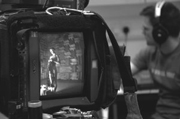
The Sound of Clothes
Over the Spring '06 season, SHOWstudio is embarking upon a series of projects devoted to exploring The Sound of Clothes. Continuing our commitment to re-thinking mainstream fashion editorial, we believe fashion audio to be a genuinely new frontier. Beyond overlaying imagery with non-specific sound - such as favourite songs or ambient music - the aim of The Sound of Clothes series is to explore a range of audio possibilities, such as discovering the actual sound a garment makes.
Anechoic is a 'collections story' project that uses sound instead of visuals to interpret the essence of key garments the A/W '06-7 season by leading fashion brands. A live recording session in a specialist recording studio -a hemi-anechoic chamber- on 1 June 2006 was used to create a series of groundbreaking interactives that for the first time in fashion media, detailed the precise sound of fashion materials such as feathers, sequins, glass crystals and beads, nylon, taffeta, leather, velvet, jacquard, zips and metallic chains.
Posted by jo at 12:16 PM | Comments (0)
May 22, 2006
Winning (and Losing) the First Wired War
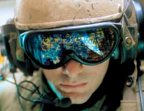
Network Hierarchies + the Connectivity Gap
defensetech.org writes on a digital divide, of sorts, that has put a strangle-hold on the theory that with communication, command and control tethered via digital networks, the armed forces of America would be more effective at conquering soverign states. Such is turning out not to be entirely the case. Most of the command units are able to make use of these networks, but evidently their effectivity plummets because units taking care of firing and dodging bullets and IEDs are off the grid, largely. And yesterday I heard a news story about two armored fighting units that could not communicate with each other — despite the fact that they were only a few meters away. Why? Incompatible communications gear. The radios were literally incompatible. Boggling, but maybe not so much considering the proprietary nature of so much of the gear.
To the US Forces pre-breakup AT&T, the insurgency is playing John Draper aka Cap'n Crunch.
Winning (and Losing) the First Wired War:
This war in Iraq was launched on a theory: That, with the right communication and reconnaissance gear, American armed forces would be quicksilver-fast and supremely lethal. A country could be conquered with only a fraction of the soldiers needed in the past.
During the initial invasion in March 2003, this idea of "network-centric warfare" worked more or less as promised -- even though most of the frontline troops weren't wired up. It was enough that the commanders were connected.
But now, more than three years into the Iraq conflict, the network is still largely incomplete. Local command centers have a torrent of information pouring in. But, for soldiers and marines on the ground, this war isn't any more wired that the last one. "There is a connectivity gap," a draft Army War College report notes. "Information is not reaching the lowest levels."
And the insurgency has taken on a hacker sensibility:
And that's a problem, because the insurgents are stitching together their own communications network. Using throwaway cellphones and anonymous e-mail accounts, these guerrillas rely on a loose web of connections, not a top-down command structure. And they don't fight in large groups that can be easily tracked by high-tech command posts. They have to be hunted down in dark neighborhoods, found amid thousands of civilians, and taken out one by one.
Why do I blog this? Institutions like the military, while barely prone to the social practice adoptions that one finds in democratic formations, in many ways test some of the directions that open society social practices can go under particular situations. Could this be an indicator of how net neutrality plays out if networks get all gummmed up with non-open standards and proprietary protocols? [blogged by Julian Bleecker on techkwondo]
Posted by jo at 11:29 AM | Comments (0)
May 19, 2006
Yo, Taxi!
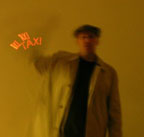
Strobing a Cab
New Yorkers hail a lot of cabs, and it can become quite competitive at rush hour when it’s raining, or late at night when bars and nightclubs close. This battle forces New Yorkers to risk their lives wading into oncoming traffic, frantically trying to get a cabbie’s attention. To give the stylish New Yorker the upper hand, I’ve developed Yo, Taxi!, a design that is sure to stop a Yellow Cab in its tracks.
Yo, Taxi! is a coat embedded with a persistence of vision display, shown through a single row of LEDs positioned in the cuff of the coat. When the wearer raises his or her hand and begins waving it in the natural taxi hailing gesture, the LEDs illuminate. The POV strobes in time with the wearer’s action, creating the illusion of the word "TAXI" floating in mid-air. [posted by Terence Arjo on Clothes Make the Man] [via WMMNA]
Posted by jo at 06:36 PM | Comments (0)
Ann de Gersem

The Life Dress
[...] I spent a lovely time talking with Ann de Gersem about her Life dress designed to give its wearer the possibility to instantly create a personal space, in which she/he can seclude her/himself from the chaotic surroundings. To create her own sanctuary, the wearer of the dress pulls up and zips the skirt at any given moment to close it around her. An air cartridge inflates the skirt to form a perfect bubble around the woman.
Similar garments inspired by the need to gain more space: the Space dress by Teresa Almeida, Wearable Warnings by Phil Worthington. [blogged by Regine on we-make-money-not-art]
Posted by jo at 06:24 PM | Comments (0)
May 12, 2006
MoBeeline + The Compass Coat
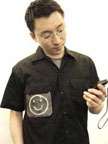
Wearables
MoBeeline allows people to send data about a user’s emotions to another’s clothes via SMS. The MoBeeline wearable Bluetooth accessory can receive data from a mobile phone. For example, one mobile phone user can send operative directions to the other's clothes and share his/her feelings and emotions by sending signals to the other person's clothes. According to the emotion the user wants to communicate, He or she will be able to modify the colors or patterns of the garment, or send emoticons to LEDs on the garment.
Video. Developed by Chang Soo LEE and HyeJoo Lee at the ITP. [blogged by Regine on we-make-money-not-art]
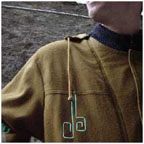
The Compass Coat, by Stijn Ossevoort, uses compass technology to read direction. The display of the information is integrated into the design of the coat offering information for both the wearer and the people around him. North is indicated through glowing plant-like shapes like a tree which is covered with moss in the main wind direction.
The coat contains magnetic sensors and 24 sections that can light up individually, using Electro Luminescent wires. The section that points north lights up while its surrounding sections glow dimly. As soon as the wearer turns, the light gradually moves onto the new section that points north.
Related: CabBoots, the navigation shoes, A belt with with tactile sense to show you the way, Melodious Walkabout. [blogged by Regine on we-make-money-not-art]
Posted by jo at 11:22 AM | Comments (0)
April 19, 2006
The Empire's New Clothes

Art, Fashion and Technology
The Empire's New Clothes - Art, Fashion and Technology workshop by Sabine Seymour & Erich Berger: Wednesday 10th of May - Saturday 13th of May at Atelier Nord Oslo/Norway. Free participation; Application deadline monday 24th of April; Send applications with CV to sense[at]anart.no
During the workshop the following topics will be adressed: * Introduction into fashion and wearables in art and design * Applicable fashion theory * Textiles, new materials and technology * Physical computing for fashion and wearables (sensors, wireless communication, etc.) * How to design * Concept development * Hands on experiments and presentations.
Clothing was among the first cultural and technological achievements of the human. Since its first intention as a second skin, communication technologies and smart materials dramatically changed its use. Clothing itself became an interface to the digital space which surrounds us. The workshop will show how textiles and technology appear in artistic practices and will introduce materials and techniques in use and in research. Participants will work and experiment on an expanded idea of fashion and technology.
Especially participants who already attended the previous workshops will be able to apply their ideas and skills on the very fabric of society.
WORKSHOP PARTICIPATION
Participation is free of charge.
Artists, designers and practitioners interested in participating are asked to apply with a CV to sense[at]anart.no
Application deadline monday April 24th.
Workshop directors and producer:
Sabine Seymour (AT/USA) http://moondial.com
Erich Berger(AT/FI) http://randomseed.org
The empires new clothes is part of the Interface and Society project at Atelier Nord, http://anart.no/projects/interface-and-society/. Upcoming workshops at Atelier Nord:
June : Media art and public space with Susanne Jaschko (DE)
September: Mobile media art with Laura Beloff (FI)
ATELIER NORD
PHONE +47 23060880
FAX +47 23060884
E-MAIL office@anart.no
URL http://anart.no
MAIL Lakkegata 55 D, N-0187 Oslo, Norway
Posted by jo at 10:33 AM | Comments (0)
March 16, 2006
Ars Electronica Winning Project 2005: [the next idea]
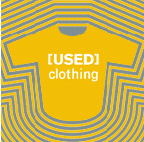
USED Clothing
Clothes are an expression of an individual’s identity. The way a person dresses is almost always directly connected to his/her lifestyle, worldview and self-image. “OK, then why not use clothing even more intensely as a medium?” mused Martin Mairinger. And the Linz native proceeded to create USED Clothing, a concept for furnishing clothes with additional information.
A radio frequency identification (RFID) chip to which the wearer can save information about himself/herself is sewn into each garment. When the item of clothing—for instance, a jacket, pair of pants or T-shirt—is sold at a special second-hand shop, the buyer can access this information online and find out about the garment’s past.
The interests and personal philosophy of individuals with a preference for the same type of clothing often resemble one another. Accordingly, the second-hand interface node just might yield interesting hookups. The project’s long-term concept envisions the establishment of a community of registered users who take advantage of the second-hand shop’s offerings not only to acquire clothing but also to establish social contacts within the network of human beings connected to the shop.
Honorary Mentions
ætherspace
knouf nick (US)
zeitkunst.org/projects/aetherspace
Maschine_Mensch
Zucali Tobias, Christopher Rhomberg (AT)
[blogged by Regine on Twenty1F]
Posted by jo at 11:48 AM | Comments (0)
March 15, 2006
TECHSTYLE NEWS
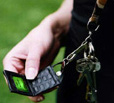
Issue #58 - March 15, 2006
BLUETOOTH WRISTWATCH FROM SEIKO: Seiko has announced their first Bluetooth watch, the BT Watch or CPC TR-006. This hi-tech watch is packed into a stylish casing and this watch will be released onto the market at the end of this year or beginning 2007. This watch is in fact an extension of your phone. It can alert you when you have an SMS or email, and it can display the number and the name of the person that is calling you. Finally, it will also alert you when the Bluetooth connection between the watch and phone is broken, so you won't forget your phone anymore.
INTERACTIVE GLASSES FROM PENNY: Swedish company Penny is developing a new type of tool to interact with a computer by the use of a person's eyes and temple muscles. Wearing a kind of regular-looking glasses, the user will see a computer screen projected into their field of vision. Founder Erik Lundström started the research for the technology used in the product C-More Interactive Glasses during the spring of 2000. The Swedish Vehicle Inspection Company has shown interest in the product.
WEARABLE COMPUTER FROM EUROTECH: Embedded computing specialist Eurotech has announced a wrist-worn wearable computer that runs embedded Linux or Windows CE. Eurotech's WWPC ("wrist-worn PC") offers a wealth of standard PC interfaces, along with several innovative wearable-specific features. It targets emergency rescue, security, healthcare, maintenance, logistics, and many other applications. It features a 72x55 mm active display area on the wrist, with touchscreen (input pen on the strap), direct-access keypad and joystick, support for USB HI devices, microphone, flat speaker, headset/stereo headphone jack.
GPS JACKET FROM GPSOVERIP: GPSoverIP and Interactive Wear have announced a trackable jacket. As well as a cell phone and an MP3 player, the GPSoverIP jacket comes fully fitted with personal tracking electronics. These are built into a small docking unit manufactured from special plastic, which can be removed before washing. Textile ribbon cable is fitted between the inside and outside lining and is not felt by the wearer. This cabling connects the docking unit to a headset fitted inside the collar, a microphone and a control panel with five buttons fitted to the sleeve of the left arm. An active GPS antenna is fitted on the shoulder. It sends each change in the wearer's position via the Internet to a server in real time.
SOLAR CELL JACKET FROM BOGNER JEANS: Bogner Jeans are working in conjunction with partners from the "Solartex" project in the state of Baden-Württemberg, to find a solution that suits alpine skiers and winter sports fans alike. A denim jacket has been developed, whereby flexible solar cells can generate up to 2.5 watts of power in opti-mum sun conditions. The photovoltaic elements are positioned in exposed areas, which are also ergonomically sound, such as the shoulders and the back. Ultra-thin, washable micro-cables are sewn into the material and direct the electrical current to a universal point, where a variety of devices or batteries can then be charged.
AUGMENTED REALITY VEST FROM INTERACTIVE WEAR: Interactive Wear has announced an integration of all the individual electronics components and systems that are required for augmented reality into a vest. Until now, this technology usually had to be stored inconveniently in bags and then wired in a way that is relatively susceptible to disturbances and that hinders movement. This wearable computing integration, however, provides new degrees of freedom. Conceivable areas of application include industrial production, medical device technology (AR operations) as well as nearly all areas of research and development.
HEAD-MOUNTED DISPLAY FROM GEARZONE: Gearzone has announced its new head-mounted display GoggleVision. The HMD gives the wearer the impression of sitting in front of a 40-inches TV screen at a distance of two meters. It features two LCD screens and a pair of stereo headphones. GoggleVision can be connected to a TV, Playstation, XBox or DVD player. Screen resolution is 640*480 pixels RGB. (in Swedish)
NANORADIO LAUNCHES WORLD'S SMALLEST WIFI CHIPSET: Nanoradio has announced the launch of its first-generation WiFi chipset solution, the NRX700, for portable electronic devices. The chipset solution, with a total die size of only 20mm2, is claimed to be the smallest footprint in the market. Additionally, it has what is claimed to be the lowest power consumption in the world in transmit, receive and stand-by compared to any one- or two-chip solution in the market today. The target markets are mobile phones, portable media devices, wearable devices and other battery driven handheld consumer devices.
RESEARCHERS SHOW BRAIN-TO-COMPUTER INTERFACE: Researchers in Berlin have come a step closer to developing a device that will enable people to write and manipulate objects by reading their mind. The device is being developed by Fraunhofer Institute for Computer Architecture and Software Technology. Even if a person who is completely paralysed cannot move his eyes left or right he can still think with the left and right parts of his brain. These thoughts or signals would be enough to activate the device. Signals from the brain are measured by 128 electrodes affixed to the subject's scalp, similar to an electroencephalogram (EEG).
MUSIC IN YOUR SHOES FROM DADA FOOTWEAR: Dada Footwear is launching a wireless footwear system dubbed "Code M". The Code M System delivers both audio and data—through your sneakers! The Code M System is integrated into the basketball sneaker's heel and tongue. It can hold up to 100 songs, running on a 6-hour battery life. To transfer songs onto the system, use the USB port on the side of the shoe. To listen to your music, use the included wireless headset, which picks up the music playing from your sneakers up to 30 feet away.
WEARABLE ELECTRONICS CONCEPTS FROM TONIA WELTER: Tonia Welter has developed a number of concepts for various wearable devices. Under the moniker "Schöne Neue Welt", Tonia has developed USB cuffs, a keyboard made of tablecloth, a USB leather bracelet, a USB silicon bracelet, among other things.
EVENTS
CTIA WIRELESS 2006 IN LAS VEGAS: As the premiere global event representing the complete wireless, mobile computing and wireless Internet industries and the largest wireless show in the world, CTIA WIRELESS 2006 brings together all industries within communications and all those affected by wireless technology for three days of intense learning and networking. Don't miss Fashion In Motion, the technology fashion show which will fuse the world of high fashion with the latest wireless technology.
Techstyle News is a free monthly newsletter providing summaries and commentaries on stories related to the next generation of mobile technology and style, produced by Thinking Materials. Please send any comments to info[at]thinkingmaterials.com
Posted by jo at 11:45 AM | Comments (0)
March 02, 2006
muk.luk.flux

Mocking the Machine Aesthetic
muk.luk.flux, by Amanda Parkes (check also her other works: Topobo and Nomad Pneumatics), is a pair of boots which change shape based on the speed of motion of the wearer. By drawing an analogy between respresentations of mechanical movement in contrast to bodily gesture, they mock the notion of the "machine aesthetic." An accelerometer in the boots tracks the wearers speed and when in motion, the boots expand into their 'engaged' position using a system of mechanical actuators in the structure of the boots.
They combine aesthetic inspiration from early 20th century Futurist design and classical Greek sculpture, with the notion of contemporary sports clothing investigating the absurdity of how fashion can change our identity, and ostensibly our performance, by making us appear faster, better, stronger with a stripe or a swoosh or a swirl... [blogged by Regine on we-make-money-not-art]
Posted by jo at 09:12 AM | Comments (0)
February 22, 2006
Wearable Game
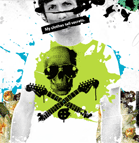
Clues Woven Into Cloth
If you find yourself wearing clothes from a new company called Edoc Laundry, beware: Strangers may walk up to you on the street to examine the intricacies of your shirt's patterns. That's because Edoc Laundry's first line, expected to launch March 1, literally weaves an episodic, multimedia game into the fabric of the garments. The Seattle-based company is believed to be the first to attempt such a fashion feat.
The idea is an extension of so-called alternate-reality games, or ARGs, in which people try to solve puzzles that are propagated online but require players to team up to find clues in the real world. Usually, the games are promotional vehicles for other products, including video games and movies. Examples of ARGs include 2004's "I Love Bees," which was a lead-in to Bungie Studios' "Halo 2" for Xbox, and 2005's "Last Call Poker," which promoted Activision's "Gun."
Edoc Laundry's line integrates an ARG into its shirts, hats and accessories. The story involves the mysterious death of the manager of a fictional band called Poor Richard. Players find clues such as words and symbols embedded in the clothes. They then head to a Web site where they can unlock complex elements of the overriding story of Poor Richard and its music..." Continue reading Wearable game weaves clues into cloth by Daniel Terdiman, CNET News.com. [via Jim Downing on Smart Mobs]
Posted by jo at 07:33 PM | Comments (0)
Keitai Girl
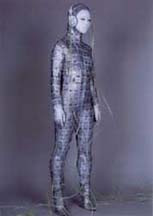
Yamaguchi Noriko is Under Our Skin
Emerging Japanese artist Yamaguchi Noriko gets under our skin thanks to what covers hers. Currently in her last year of an MFA program at the Kyoto City University of the Arts, this 22-year-old artist from Kobe tackles issues as diverse as technology, mythology and feminism through bodily transformation and endurance. Yamaguchi uses her body to challenge present-day social mores by quite literally camouflaging herself with materials such as red azuki beans, golden thumbtacks and silvery cell phone keypads which become a constructed second skin that acts as a meaning-laden barrier against the world beyond. The art world in Japan has already recognized Yamaguchi as an up-and-coming talent: in 2004, she was selected by famed photographer Hosoe Eikoh as a recipient of the Panel of Judges Award at the 21st-Century Asia Design Competition award held by the Kyoto University of Art and Design and again by Morimura Yasumasa as a winner of a young artists’ competition hosted by the Osaka Contemporary Art Center.
Yamaguchi’s work is awash in sexual politics due to the extreme modifications she enacts during performances or in front of the camera. In Keitai Girl (2003), the artist dons a skin-tight body suit reminiscent of metallic fish scales that is carefully crafted from cell phone keypads. Her face painted in the traditional powdery white makeup of Butoh, Yamaguchi wears large headphones and is draped from head to toe with wires seemingly ripped from a telecommunications command center, setting her adrift and alone in the ether. The suit, thanks to its digital keypads, begs to be dialed, thus showing the vulnerable position of the artist within the grasp of any number of anonymous hands that might reach out and “touch someone.” In fact, certain guests are given the telephone number of her body suit and can dial her up from their own cell phones and engage Yamaguchi in conversation during her performances. Thanks to the widespread use of cell phones, or keitai, in Japan, Yamaguchi created this suit—a full-body prosthetic that turns her into a walking and talking cellular device—to investigate the future development of the human body and its interaction with technology.
In another series, “Ogurara Hime,” or “The Princess of Ogura” (2004), Yamaguchi covers portions of her body with red beans to visually recreate the Japanese myth of Princess Ogura who became a human garden whose body sprouted forth azuki beans. Yamaguchi uses this ancient Japanese tale as a metaphor in her visualization of the female body as a site of production on a multitude of levels. In one image, long cords of red beans sprout forth from Yamaguchi’s head and attempt to take root in the ground just below her recumbent body. Her pale white flesh and exposed breasts become fertile ground that gives rise to crops and, perhaps more likely, to male desire and sexual objectification.
With her sexually charged examinations of the human body and its potential transmutations at the hands of technology and society, Yamaguchi Noriko’s skin trade is bound to remain on the Japanese art market for some time to come.
- Eric Shiner
Via Asia Pacific Magazine. [via reBlog]
Posted by jo at 08:04 AM | Comments (0)
February 21, 2006
Ana Viseu’s Sociotechnical Worlds:

The Visions and Realities of Bodynets
Imagine two cities separated by a river and connected only by boat. Now think of the changes that are brought about by the construction of a bridge; Transformations will be experienced in both cities. These transformations will, to a great extent, be caused simply by the appearance of the new artefact (bridge). But, the properties of the artefact will also influence the character of the changes. There is, for example, a great difference between a small wooden bridge that can only carry pedestrians and bicycles, and a steel bridge that is equipped for cars, trucks and trains, but not for pedestrians. The characteristics of the bridge will affect the two cities it connects. The contrary is also true, that is, the characteristics of the cities will affect the shape and use of the bridge. Before the actual building of the bridge, studies were done (hopefully) and, assumptions were made (certainly), regarding the characteristics and needs of the cities on both sides of the river.
What we see here is an example of mutual-shaping interaction. Much in the same way that the social (the two cities) is shaped by the technical (the bridge), the bridge is shaped by the cities it connects. This is true both of the processes of development and implementation of the technical artefact (the bridge).
However, it is also true that the identity of the elements/actors is not infinitely fluid or malleable. Technological artefacts have characteristics that need to be taken into account in this mutual shaping relationship. For instance, a bridge that is made for pedestrians may be used by bicycles, perhaps even cars, but certainly not by trains.
This same metaphor applies to bodynets. Bodynets are bodies networked for (potentially) continuous communication with the environment (humans or computers) through at least one wearable device—a body-worn computer that is always on, always ready and always accessible. Bodynets can be thought of as new bridges between individuals and the environment (constituted by humans & nonhumans, or things and non-things). As they (re)connect and mediate, they transform (and are transformed by) all elements involved in this interaction. Hence, these technological artefacts are not merely tools to be used, but active shapers of experience. A bodynet can be used, for instance, as a "reality mediator" (Mann 2001), that is, it can alter, by enhancing or diminishing, one’s perception of the world. Steve Mann’s Eyetap is perhaps the best example of this. The Eyetap transforms the eye into a camera and a screen where reality is projected. When the eye looks reality is recorded and then projected onto the eye itself. This allows all sorts of manipulations, for instance, it is possible to do retroactive recording!
Bodynets, these new bridges, also contain assumptions about that which they connect, and these assumptions affect their shape, the nature of their mediation, and the behaviors they enhance. Thus, these bodynets are not neutral or ‘transparent’ technological artefacts. In fact, all technologies have biases. In 1951 Harold Innis, in a ground-breaking book The Bias of Communication, argued that while stone (communication through stone) is biased towards space (it can not be easily transported), papyrus is biased towards time. Nowadays, it is frequently said that television is biased towards fragmentation and sound bites. What are the biases of bodynets?
The metaphor of bodynets as ‘bridges’ spells out the broader theoretical foundations of this study. It stresses the networked character of a (socio)technological project, and emphasizes the bi-directional influence that actors’ actions have. Finally, it also stresses the point that technologies are socially constructed and reflect the society that produces them; And that society, on the other hand, is shaped by its tools and cannot be understood without them (cf. Latour 1993; Castells 1996; Callon & Law 1997; Bijker 1995).
All technologies are sociotechnologies, they are constituted by technical and social elements, i.e., not only are they materializations of a given view of society and behavior, they also enhance or constrain social dynamics. A bodynet that is equipped only with a transmitter allows its user to transmit data, but not receive it. If this transmitter is controlled by a third party, then the user has no control over the data flow. If the bodynet is equipped with a transceiver and is controlled by the user, then the user is able to control every piece of information that enters, and leaves, his/her personal space. In a sense we can say that the way a certain technology is, that is, its present shape, shows us the result of the struggle between different actors (Latour 1991). [...]
[via nicolas on pasta and vinegar]
Posted by jo at 12:04 PM | Comments (0)
February 13, 2006
man in|e|space.mov
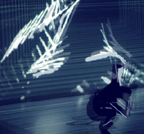
Three Views/Visions of the Body
"ABSTRACT: The article documents the theoretical and aesthetical basis of the interactive dance performance man in |e|space.mov. The text discusses the abstraction of the human body in this performance by an interactive costume of light whose motion is analyzed by a 3D motion-rendering programme, which assembles and recombines the captured frame in real time in electronic 3D space. Thus appears a juxtaposition of 3 visions on the body making up the representation: the eye of the spectator, the camera and the 3D camera view: 3 visions constituting the contemporary body. Furthermore, the text questions the dislocation of the sensual body in physical space to the reading of body as a data in the matrix of virtual space in performing arts. In order to investigate the meaning of the aesthetics of abstraction, and dislocation of human body in performance art and motion analysis, the article puts ‘man in |e|space.mov’ in perspective to historical references of the 20th century, in particular to the work of the physiologist and pioneer of cinema J. E. Marey and the Bauhaus artist O. Schlemmer." Man in |e|space.mov/Motion Analysis in 3D Space by Wolf Ka, ACM MM in Singapor.
Next performance: Where: Festival Hors Saison, Le rendez-vous danse d'Arcadi, Ferme du Buisson; When: 25+26/02/2006 16h/18h; Production: res publica & lab[au] >> danseuse: Marianne Descamps, Musique: Marc Wathieu.
Posted by jo at 09:50 AM | Comments (0)
February 07, 2006
RC2|Relational Clothing + collecting fragments

Intervention by Johannesburg Artist Jose Ferreira
As covered by Carine Zaayman on Artthrob, the Very Real Time project launched its second phase at the Drill Hall (Point Blank Gallery, downtown Jozi) this past weekend, hosting, "Two panels of selected speakers… chaired by Gregg Smith and …an intervention by Johannesburg based artist, Jose Ferreira."
This work consists of a series of journeys and a garment. Appearing to be an ordinary overall, it unfolds and translates into various forms, provoking unusual relationships. It is at once a vessel for shelter, a protective unit, and gatherer of ephemera. …The focal point of the work is to extricate new readings of social interactions in this urban context that may have become accepted, habitual and even suspicious. The work is an exploration of urban survival, self-preservation, and a dreaming of possibilities. …My intention is to make a work that embraces the multiplicity of an urban Johannesburg experience. [blogged by nathaniel on nathanielstern.com]
RC2|Relational Clothing + collecting fragments
This work consists of a series of journeys and a garment. Appearing to be an ordinary overall, it unfolds and translates into various forms, provoking unusual relationships. It is at once a vessel for shelter, a protective unit, and gatherer of ephemera. A series of 'walks' through the downtown area of Johannesburg will act as a catalyst, and the user agent provocateur of new and exploratory relationships. The outfit is likely to highlight existing issues like patterns of social discord. The wearer will gather information in various forms, both physical and digital, 'embodying' an experience of the inner city. The focal point of the work is to extricate new readings of social interactions that may have become accepted and habitual. The work is an exploration of urban survival, self-preservation, and a dreaming of possibilities. The garment also has interesting references to its origins. During medieval times a one-piece garment was used by jesters and alchemists as a symbolic outfit which in their view, were aids to avoid disturbances in the flow of energy in the body.
This is a project that imagines technology as a parallel universe using desire rather than scientific quantification as a measure of fulfillment. Using these vectors of reference we are pondering questions like, is it possible to construct a prototype garment that would in itself become a living organism, an amalgamation of experience and live interconnected parts? Without being too preoccupied with the aesthetic associations of fashion the work articulates the relationship between the individual and a social body, and the eminent overlapping of the two. It seeks to articulate in particular a very simple ethical question, what is the nature of the distance between my body and the world?
The garment itself will look ordinary, with various 'functions' pervasively located within an exterior shell. The apparatuses on the garment are really a means to augment it with various loci of information - a way of capturing and interpreting data. The costume itself will function as an object with various different utilities, paraphernalia that is geared toward social provocation. The work also remains functional without any of the electronic components, even if the technology were to be shut down completely it would remain user friendly. Various components of the outfit will become more apparent or 'emerge' according to different situations. It will transform, unfold, adapt and reconfigure according to the situational constraints of various contexts, and become 'infected' by its surroundings. The work is essentially about potential, that existing between the individual and a larger social body, and the way one negotiates personal space within the broader collective of a society, community or group. Interaction with the immediate context will be the point of reference for the interventions, which will be in the vicinity of the Drill Hall. In that way it will function as a type of urban survival kit and social integration tool - an activator of real and imagined spaces.
There are examples where clothing has been used as a provocative agent like Lygia Clark's overtly political outfits criticising Brazilian authorities and censorship in the late sixties, to Laurie Anderson's performative apparel. In many cases, due to the bulky apparatuses of the times, the instruments were clearly visible within and without the garments. Today, with the advent of nano technology, much of this instrumentation has become stealthy, integrated in some form or another into the structure of the object. This work is about exploring possibilities in which those technologies can be used to interrogate notions of difference, and similarity, by looking at how people are constantly mapping out their existence in urban environments. The idea is to construct a garment that uses various devices embedded into its structure, to record, manipulate, and transmit information about that person and their surroundings. This information will not be entirely statistical but rather more ephemeral. It might for instance gather relational information about the proximity of other persons and buildings - perhaps an Auric Transmitter? Perhaps it will measure presence?
By looking into subtle variations in locality and behaviour it might be possible to map an individuals journey. How does it look/feel to experience someone else's journey as they walk through congested areas, isolated landscapes, in the proximity of others/buildings etc? What would a visual manifestation of this journey look like? How are the boundaries between people perpetuated, and how do they change in an urban environment where unconsidered situations are forced upon one another? How can the garment be used to create a space of seclusion allowing the subject immediate respite from their surroundings? Can it become a cipher associated with security, like a temporary safety net?
My intention is to make a work that embraces the multiplicity of an urban Johannesburg experience. In collating information that is ephemeral and open to multiple interpretations, I hope to engender a more imaginative, playful interpretation of that experience. The notion of venturing into possible contested spaces and coalescing the experience into other activities has an established history; activities like Capoeira for instance, manifest out of the frission stimulated by potential conflict - turning one activity, associated with aggression, into a more poetic form of expression.
RC2 is a work made possible through collaboration. This process has been facilitated by Strangelove, a fashion design duo that have worked on several projects. Tegan Bristow, an artist working in Digital media, has spent much of her time devising ways in which the digital components might function. And Dorothee Kreutzfeldt who has put immense energy into curating the event.
Posted by jo at 11:01 AM | Comments (0)
January 27, 2006
Finger Ring
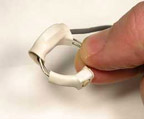
Social Polling
Finger Ring is a system in which a cell phone decides whether to ring by accepting votes from the others in a conversation with the called party. When a call comes in, your phone first determines who you're discussing with by using a decentralized network of autonomous body-worn sensor nodes. It then vibrates all participants' wireless finger rings.
Although the alerted people do not know if it is their own phones that are about to interrupt, each of them has the possibility to veto the call anonymously by touching his/her finger ring. If no one vetoes, your phone rings.
Other Ring Phone concepts: The Finger Phone - The Finger Phone is a small bluetooth headset that you can wear like a ring. It remains connected to your cell phone through bluetooth; Technojewelry - Penta Phone, Ring Phone and GPS Toes - Technojewelry for IDEO incorporates emerging electronics into everyday attire. Penta Phone and Ring Phone are concepts for mobile phones; The ring phone concept - A mobile phone encapsulated into a ring you wear on the finger, won the 2004 Sony Ericsson Phone Concept Design Competition in China; The Ring Phone - The winning submission for the "2004 Siemens Design Challenge"was a phone consisting of two finger rings, one ring for listening and one for speaking. [blogged by Emily on Textually]
Posted by jo at 03:56 PM | Comments (0)
January 26, 2006
Vilkas + Kukkia
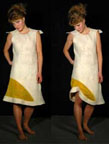
Kinetic Dresses
The hemline of the Vilkas dress rises over a 30 second interval to reveal the knee and lower thigh. The very light yellow cotton element of the hand-made felt garment contracts through the use of hand-stitched Nitinol wires. Once heated, the shape-memory wire pulls the cloth together, creating a wrinkling effect.
The hemline is programmed to rise autonomously. The behavior of this kinetic dress can be playful and even desirable, but can also be embarrassing in the wrong social situation. The wearer can wait for the hemline to fall or can actively pull it back down. This initiates a physical conversation between the wearer and the garment, as they fight over control of the body’s real estate.

The Kukkia dress is decorated with three animated flowers. Each flower opens and closes over (on average) a 15 second interval. The flowers are constructed out of felt and silk petals that provide relative rigidity and conceal the Nitinol wire stitched onto the back. When heated, the wire shrinks and pulls the petals together, closing the flower. As it cools down, the rigidity of the felt counteracts the shape of the wire, allowing the flower to open again.
By Joanna Berzowska (Concordia University). Check also her Intimate Memory clothing. Photos by Shermine Sawalha.
See also CuteCircuit's Kinetic Dress and a wearable system for showing off tattoos. [blogged by Regine on we-make-money-not-art]
Posted by jo at 09:41 AM | Comments (0)
January 20, 2006
Ether Beat
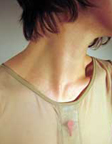
Under Beat, My Heart Beats for You
Ether Beat are compatible garments that sense, process, transmit and receive the ECG wavelength. A singlet (Under Beat) houses the ECG electrodes and connects to either the scarf or the blouse.
The under garments are enabled with ECG sensors and processing equipment while the outer garments house signal processing equipment, small vibration motors, and radio transceivers. The garments receives the heartbeat wavelength of your remote friend/lover/relative and transmits it as vibration through your garment. Using inexpensive wireless components, tests have demonstrated the devices working up to a distance of 25 metres, in an electrically noisy environment. Future prototypes will utilise Bluetooth or similar technology to allow for a more remote 2-way transmission occur.
The project questions whether usage of the apparatus will encourage physiological empathy - the moderation of ones heartbeat to syncopate with that of the remote other; and emotional empathy - the establishment of a remote emotional linkage. A project by Leah Heiss. Also by Heiss: the Empathy Vest. [blogged by Regine on we-make-money-not-art]
Posted by jo at 02:23 PM | Comments (0)
January 19, 2006
Laura Beloff
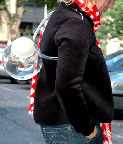
Fruitfly Farm
The Fruitfly Farm is Laura Beloff's second piece in the same series as The Head, a "wearable sculpture" with a connection to the internet, a camera and a public access via sms. The both pieces have a similar technical structure, which is accessible for the audience via mobile phones.
But while The Head is observing outwards the surrounding society, the Fruitfly farm observes a full society in small scale -the fly nest. Both works address the society and surrounding environment as the their theme. The fact that they are wearables allows them to "live" among their audience.
Related: the Plant Backpack and the fabulous Beehive Hat, both by Harmut Stockter. [blogged by Regine on we-make-money-not-art]
Posted by jo at 11:29 AM | Comments (0)
January 13, 2006
TapTap

Emotional Wrap
TapTap is a scarf that can record, distribute and play back affectionate touch for emotional therapy. Based on haptic devices, taptap can be re-configured to record and play back the touch that is most meaningful to each user. It is made from felt in two layers: one grey one that faces the public and a pink layer that touches you and contains the haptic modules in specially designed pockets. Taptap can be worn as a regular scarf, and custom touch modules can be placed in powered pockets within to record and play back touch where and when you want it.
Three kinds of touch can be played back: the pressure of touch, the warmth of contact and the percussion of a friendly tap. You can record these sensations by placing the record/playback modules in the pockets of the scarf where they receive power. To play touch back, place the modules where you want to feel the touch and wrap the scarf around yourself tightly.
Movie showing wmmna's favourite model interacting with the scarf on the website. PDF. Developed by Leonardo Bonanni, Jeff Lieberman, Cati Vaucelle and Orit Zuckerman. The project is part of the second Seamless fashion show, to be held on February 1, at the Boston Museum of Science.
More scarves: intimate memory clothing, Chameleon scarf, Wearables for a distant society, the emotional wardrobe, summer scarf, Pod the massager, and whiSpiral. [blogged by Regine on we-make-money-not-art]
Posted by jo at 05:03 PM | Comments (0)
Wearable Instrument Series

Co-Dependent Musical Appendages
The Wearable Instrument Series, by Marisa Jahn and Steve Shada, turn their wearers into breathing musical instruments. The flesh colored accessories resemble prosthetic devices, suggesting that human relationships can be regarded as corporal, affective, and psychic appendages...
Exhausted are two vests sewn with an accordion-like instrument between. As the two participants embrace and pull away their movements generate sound. The bellows of the "accordion", when extended to their maximal capacity, reveal the word exhaust. In other words, the air fills the bellows when the individuals, frustrated ("exhausted") by each other, pull apart. This air is expelled/exhausted as the indivduals embrace, paradoxically suggesting that through embrasure the frustration is dispelled or exhausted.
Each Hug n' Harp vest features a stringed instrument component at the back. The participants can only play their partner's instruments. Additionally, with the instrument's orifice positioned in a location accessible to others, the wearer finds him/herself in a vulnerable position wherein anyone can access the vest and play his or her strings...
The title suggests the dual dynamic within co-dependency: to hug (embrace/nurture) and to harp (to nag, to pick at). None of the suits will function properly if one wears them alone. Participants must put themselves in compromising poses with others, while working together to create music. Marisa Jahn's work will be shown at the second Seamless fashion show, to be held on February 1, at the Boston Museum of Science. [blogged by Regine on we-make-money-not-art]
Posted by jo at 04:52 PM | Comments (0)
arabiia

Re-dressing Religion
Across societies and countries, dress has always played a pivotal role in cultural and political expression. Attire, especially when it comes to women's attire, figures in many parts of the world as a means of representing and expressing oneself (undressing religion, Linda Arthur).
Arabiia--by Ayah Bdeir--is a convertible outfit that looks at two opposing images of the Arab woman: the sexualized belly dancer and the veiled opressed woman. The costume is equipped with two servo motors and a switch. It enables the woman to flip modes between two extreme stereotypical representations typically attributed to arab women.
Ayah Bdeir is a second year masters student in the MIT Media Lab. She is a member of the Computing Culture Group, which creates unique technologies for cultural, political and media applications. She recently graduated from the American University of Beirut (AUB) with a Bachelor of Engineering in Computer and Communications Engineering and a minor in sociology.
Ayah's research in the Computing Culture Group looks at the role technologys plays in cross cultural communication; being both a vehicle for the representation of identities and a tool to create engaging dialogue amongst cultures.
Posted by jo at 10:15 AM | Comments (0)
January 12, 2006
The Fashion of Architecture

CONSTRUCTING the Architecture of Fashion
The Fashion of Architecture: CONSTRUCTING the Architecture of Fashion--
Galleries: Judith and Walter Hunt Gallery, Mezzanine Gallery, Kohn Pedersen Fox Gallery, HLW Gallery, South Gallery; January 11–March 11, 2006
Architecture is making its presence felt in fashion as the pliable metals, membrane structures, lightweight glasses and flexible plastics used in building construction are creeping on to the catwalks. At the same time, architects and interior designers are borrowing the techniques of pleating and draping from traditional tailoring to design buildings that are interactive, inflatable, and even portable. Works by practitioners such as Zaha Hadid, Winka Dubbeldam, Shigeru Ban, Kivi Sotamaa, David Adjaye, Block Architecture, 6a Architects, Lars Spuybroek, Stuart Veech and Meejin Yoon are showcased alongside architectonic apparel from fashion mavericks such as Martin Margiela, Hussein Chalayan, Yoshiki Hishinuma, Yeohlee, Pia Myrvold, Yohji Yamamoto, Boudicca, Eley Kishimoto, Kei Kagami, Michiko Koshino, Stéphanie Coudert, Simon Thorogood, Nicola de Main, and Arkadius. The exhibition features a special installation from Paris-based artist Lucy Orta.
Curator: Bradley Quinn, FRSA, a British author and critic based in New York. [posted by Regine on 21f]
Posted by jo at 05:53 PM | Comments (0)
January 09, 2006
urbanhermes

Redefining Fashion and Identity
Fashion signals are important in displaying one's quality of access of information. electronic fashions, information that may circulate within blog circles or online communities, experience rapid fashion cycles as the information is easily disseminated and regenerated. physical fashions, such as clothing, are unable to update as quickly as information flow due to their physical structure. urbanhermes is an augmented messenger bag that aims to incorporate the fluid, expressive signals of electronic fashion into the constrained, material-based environment of physical fashion. The bag is able to change its dynamic, temporal display within the context of its social environment, providing versatile means for face-to-face signaling. By accelerating the physical fashion cycle, urbanhermes facilitates more meaningful and communicative representions of self-identity. See urbanhermes: social signaling with electronic fashion [pdf] [msword] [via Information Aesthetics]
Posted by jo at 02:05 PM | Comments (0)
January 06, 2006
Barcode Textiles

Ringtone Garments
Industrial designer Christopher Glaister and fashion designer Michelle Shakallis's barcode textiles (click on View Projects) are decorated by a pattern that translates a piece of music (When the Saints Go Marching In) into a barcode. The pattern can be turned back into real music or a ring tone by scanning it with a modified camera phone. The tune can then be used as the ringtone for that mobile phone.
Been looking for a link to that project for months, found it via a post on pixelsumo.
Other projects by Chr. Glaister: Communicating concrete and Olson, the independent camera. [blogged by Regine on we-make-money-not-art]
Posted by jo at 03:03 PM | Comments (0)
January 04, 2006
iNSTANT eGO

Intimate, Instantaneous, Nomadic Architecture
iNSTANT eGO is a concept dwelling that allows the emergence of intimate electronic space in the middle of the urban public space. Plugged to clothing, iNSTANT eGO is an inflatable cluster of intelligent tissue folded over, waiting to be unfolded.
The flexible space starts out like a hood in a raincoat and it can expand to swallow the user as a whole. Once s/he is inside, the user sees the confined space becoming infinite through the boundless realm of virtual reality projected onto the inner skin of the structure. The user can then travel into this infinite space by using electronic sensors that manipulate the projected images.
Created in 2000 by Hyoungjin Cho, Rémi Feghali, Adrien Raoul. Related: wearable architecture. [blogged by Regine on we-make-money-not-art]
Posted by jo at 10:58 AM | Comments (0)
December 18, 2005
Counter-Surveillance Headdress
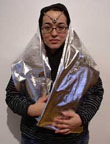
Become a Target of Heightened Surveillance
The purpose of the Counter-Surveillance Headdress, by Gloria Sed, is to empower the wearer by allowing him/her to claim a moment of privacy in the Big Brother world.
The design of the headdress borrows from Islamic and Hindu fashion to comment on the racial profiling of Arab and Arab-looking citizens that occurred post-9/11. The design of the headdress is thus a contradiction: while its goal is to hide the wearer, it makes the wearer a target of heightened surveillance.
The laser tikka (forehead ornament) is attached to a hooded vest and reflective shawl. The laser is activated by pressing a button on the left shoulder of the vest. When pointed directly into a camera lens, the laser creates a burst of light masking the wearer’s face. The wearer can also use the reflective cloth to cover the face and head. The aluminized material protects her/him by reflecting any infrared radiation and also disguises the wearer by visually reflecting the surroundings, rendering the wearer’s identity anonymous. For more information on camera zapping with lasers. At the itp Winter Show, on December 18 and 19, ITP, 721 Broadway at Waverly Place, 4th Floor, South Elevators, New York. [blogged by Regine on we-make-money-not-art]
Posted by jo at 01:10 PM | Comments (0)
December 13, 2005
Finger Whisper
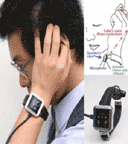
Wired, Body and Soul
In Getting Your Body (And Soul) Wired, Newsweek Magazine reports about Finger Whisper, a wristwatch-phone that transfers voice signals via your body:
"In his gadget-filled office at Tokyo Medical and Dental University, Prof. Kohji Mitsubayashi tells a visitor to touch a transmitter with one hand and a receiver with another. Voila! A jaunty TV jingle blares from a pair of attached speakers. Surprised, the visitor releases both gadgets, and the music stops. The simplicity and strangeness of becoming a human circuit—with electrical signals coursing through one’s body from fingertip to fingertip—is so fascinating that visitors usually repeat the act. “Fun, isn’t it?” says Mitsubayashi, grinning.
Not just fun. Japan is abuzz over the potential of such body-based technology as the ultimate wireless networking tool. A string of Japanese companies are experimenting with systems that use the human body to conduct electricity—some manipulating weak currents that pass through the skin itself (as body-fat scales do), others taking advantage of electrical fields on the surface of the body. Associated products are on the way. The question is whether this represents a paradigm shift in the way we think about wires." [blogged on wristfashion.com]
Posted by jo at 12:21 PM | Comments (0)
December 02, 2005
VirtuSphere
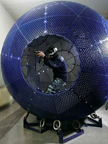
Move Freely in a Fully Immersive Environment
VirtuSphere revolutionizes the way humans interact with computers. The method and system provide infinite space and the most immersive experience for simulated training, exercise and gaming.
The VirtuSphere platform consists of a large hollow sphere that sits on top of a base and allows the sphere to rotate 360 degrees. Wearing a wireless, head-mounted display, users can step inside the sphere to fully interact in immersive virtual environments. The VirtuSphere enables 6 degrees of freedom – one can move in any direction; walk, jump, roll, crawl, run over virtually unlimited distances without encountering real-world physical obstacles.
VirtuSphere systems are made to client specifications and typically include an easy-to-assemble sphere, a base platform that enables it to rotate, a head-mounted display, 3D sensors, sphere rotation trackers, a computer, device drivers and 3D software applications. [via Rhizome]
Posted by jo at 11:19 AM | Comments (0)
November 23, 2005
TechnoLust

Zones Light Up via Electronic Caresses
Interesting concept of wearable gaming device. TechnoLust blends technological lust with a program to reawaken carnal lust. The gaming device takes advantage of wireless Internet technology. Players wear it as an undergarment to travel out of the virtual world of the computer to find and play with opponents
TecnoLust is a game of body erotic zones that are lit up by electric caresses. Upon entering the game players select the mode they want to play within, this sends out a frequency which attracts other players set on the same game and frequency. When a participant encounters another a game of electronic caresses begins where pulses are sent back and forth electronically to arouse the senses. Designed in 2002 by Peter Allen and Carla Murray, KnoWear. [blogged by Regine on we-make-money-not]
Posted by jo at 06:51 PM | Comments (0)
November 15, 2005
StartleCam

Affective Wearables
"Abstract: StartleCam is a wearable video camera, computer, and sensing system, which enables the camera to be controlled via both conscious and preconscious events involving the wearer. Traditionally, a wearer consciously hits record on the video camera, or runs a computer script to trigger the camera according to some pre-specified frequency. The system described here offers an additional option: images are saved by the system when it detects certain events of supposed interest to the wearer. The implementation described here aims to capture events that are likely to get the user's attention and to be remembered.
Attention and memory are highly correlated with what psychologists call arousal level, and the latter is often signaled by skin conductivity changes; consequently, StartleCam monitors the wearer's skin conductivity. StartleCam looks for patterns indicative of a ``startle response'' in the skin conductivity signal. When this response is detected, a buffer of digital images, recently captured by the wearer's digital camera, is downloaded and optionally transmitted wirelessly to a webserver. This selective storage of digital images creates a ``flashbulb'' memory archive for the wearable which aims to mimic the wearer's own selective memory response. Using a startle detection filter, the StartleCam system has been demonstrated to work on several wearers in both indoor and outdoor ambulatory environments." From StartleCam: A Cybernetic Wearable Camera by Jennifer Healey and Rosalind Picard.
Posted by jo at 09:05 AM | Comments (0)
November 10, 2005
Embrace

Provoking Shared Experiences
A concept proposal for an interactive bracelet with little informative displays, to provoke shared experiences between wearers in close proximity. Embrace stands for the 'brace'-lets fitting together & representing its users, who 'embrace' one another. The wearable display consists of several nodes: a LCD screen displaying wirelessly sent images, a battery, a camera lens that constantly records images until the user specifically shoots an image, & a scent-palette housing that emits 1 of 5 odors chosen by the owner of the device indicating an incoming image from their 'significant other'. see also fuse for a conceptually similar working prototype. [blogged on infosthetics]
Posted by jo at 04:48 PM | Comments (0)
November 03, 2005
AwareCuffs
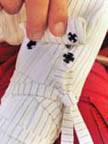
Off the Cuff WiFi Detection
AwareCuffs, the 2nd item of the AwareFashion collection, inform the wearer about wireless hotspots in her environment. Just by glancing at the cuffs, a person can check if wireless LAN is available. Small light patterns that appear on the cloth indicate if wireless LAN is available and the quality of service.
One cuff has an attached pocket and flexible transparent glass fibres are woven into the cloth. The wifi sensing technology is hidden in the small pocket. The circuit board in the pocket displays the quality of service by LEDs in different colors. The LEDs are connected to glass fibres, the light travels through them and small light spots appear at the end. When the technology pocket is detached the cuffs solely consist of cloth and glass fibres and can be washed. This concept also makes it possible to easily replace the technology function of the cuffs.
By Richard Etter and Diana Grathwohl. Other works by Richard Etter: The shirt that senses switched-on mobile phones and Melodious Walkabout. Related: Hotspot Bloom. [blogged by Regine on we-make-money-not]
Posted by jo at 08:45 AM | Comments (0)
October 18, 2005
exhale:
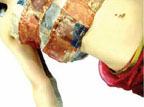
breath between bodies
"At Siggraph 2005 in Los Angeles, one set of skirts stole the e-tech show. The line of techno-couture, exhale: breath between bodies by the whisper(s) research group, takes embodiment seriously in ways that our purely electronic (ARGs and biowriting aside) approach to digital character art often does not. What we see here is not just the exercise of novelty or experiments in electronic composition, but a collective of theoreticians whose hands are busy at the work of stitching communal interaction.
What do the skirts do? They allow your body to communicate through passive (autonomic, if you will) and active means. The ensembles (for they are more than just skirts), using breath bands and vibrators, translate your breath and heart rate into digital signals and transmit this information, only to have it be decoded as sound or vibration. In essence, your breath and heart rate become a language. Your body signifies in its biological semantics. With respect to WRT, the digital character of this art resides beneath the exhale.
The whisper[s] research group based out of Simon Fraser University’s Interactivity Lab has designed, threaded, and painted this “a-wearable” technology, allowing bodies to communicate on an autonomic level. Within this project are three levels of interaction: self-to-self, self-to-other, and self-to-group. First, the wearer can access their own data. Second, through contact with sensors, a wearer can activate a connection with another person, allowing them to receive the senders somatic data. Finally, the wearer can transmit their breath data to a wall of speakers, which then transmits the information throughout the room aurally.
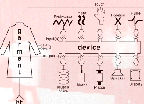
The enmeshed product is melange of cyborg connectivity, future-fashion, and intimate transmission, reading your body and sending the signals through your air, reminding you that your breath has been doing this for quite some time. As the whisper(s) website describes,
the aesthetic of whisper(s) garments is unique and deliberately ambiguous. Fashion for us is vastly innovative and seductive. Prosthetics are creepily creative. The opulent is fundamentally not about cost but about sensuality. Skin is the richest source of inspiration: marked, exposed, nurtured, celebrated.
This is a playful work and yet serious as flesh.
This is group of engaged theoreticians. Thecla Schiphorst of Simon Fraser University is listed as lead on this, but I first heard about it from Susan Kozel at the (dis)junctions: theory reloaded conference at UC Riverside, a talk co-sponsored by the UCR Mellon global_interface workshops. At Riverside, Kozel spoke of the body electric, or wrapped in electronic paraphernalia and research conducted with soldering iron. If you visited their booth at Siggraph, you no doubt saw a team stitching, wiring, and programming going on. Here was the seamstress-programmer-critic, some fulfillment perhaps of Shelley Jackson’s Patchwork Girl.
Seeing the workers with their conductive paint and pdas, I was reminded again of the work behind hand-made interfaces and how different life is behind the technoculture runway. These researchers were up night and day with needle and thread and paintable wires. They seemed materially connected to the process of making and, of course, the technology, not just because they (wearers male or female alike) had to stand still (like proper Victorian ladies) while a technician, usually female, worked on their transmitters but because they were adjusting connections by hand. This is not a women’s project, since among the women (Camille Baker, Diana Burgoyne, Gretchen Elsner, and Sang Mah), were such presumably male names as (Calvin Chow, Jan Erkku, Norm Jaffe, Robb Lovell, Lars Wilke, and Adam Marson). But their does seem to be a purposefully womens’ tech-art aesthetic here. My own tour guide was Lone Koefoed Hansen, the Danish researcher who is in residence at Simon Fraser this fall.
This project is in an engaged networked women’s theoretical praxis. I call this women’s theoretical practice not because all of those who worked on the project were women, but because of a kind of sensibility behind the project that links bodies, seams, and circuits. It is to say, that the project sews itself into conversations of embodied female networks of art (and many other combinations of those five words).
We-make-money-not-art recently featured an “Empathy Vest,” which seems on the face of it to share affinities with this project. The choice of styles, the “sensually evocative skirts worn close to the body” compared to the more androgynous Empathy Vest (with its evocation of Kevlar and circuit boards) might give some sense of differences between the projects. Perhaps one foregrounds gender difference and play while the other offers to break through our bullet-proof physical alienation.
More WRT on Siggraph." [blogged by Mark Marino on WRT]
Posted by jo at 06:57 PM | Comments (0)
ReachMedia ::
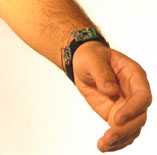
on-the-move interaction with everyday objects
Can we merge the virtual world with the physical world? ReachMedia--by Assaf Feldman, Sajid Sadi, Emmanuel Munguia Tapia--is a system for seamlessly providing just-in-time information about everyday objects. It is built around a wireless wristband with an RFID reader and accelerometers. The wristband detects physical objects that the user is interacting with, and retrieves relevant and personalized information via a smart phone. The user can then have a hands and eyes free interaction with the application by using a unique combination of slight gestural input and audio output. See Bracelet Navigates Net, Technology Review News. Download PowerPoint presentation. [via]
Posted by jo at 06:44 PM | Comments (0)
Faraday Cage
Blocking RFID
To avoid being tracked by readers, Mikey Sklar built an RFID Pocket Replacement that involves building a faraday cage around your clothing's RFID tags. Just rip out a pocket from a pair of jeans and replace it with a cotton like fabric which contains enough conductive material to block most RFID tag frequencies. Have a look at the PDF presentation of his project, it's amazing to see how much RFID is present in our lives. Movie. [via Regine on we-make-money-not]
Posted by jo at 06:26 PM | Comments (0)
October 14, 2005
random search
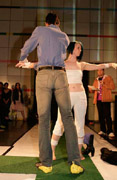
Stripping Away Our Liberty
random search--by ayah bdeir--is a subtle, reactive undergarment. It records, shares and studies the experience of invasive airport searches on behalf of our silent, abiding, fearful bodies. A thin suit, worn underneath clothes, is equipped with pressure sensors. Different pressure application results in stronger projection of that search process.
The first appearance of random search was at the Seamless electronic fashion show at the Media Lab. The focus of this prototype was on the behavior of the suit. As the inspector ran his hands and metal detector across the wearer’s body, the suit became a vehicle for the wearer to share the invasive experience she was going through. The suit served as the voice of the wearer, too nervous and worried to verbalize the feeling of physical and moral aggression. As touch and pressure was applied trails of LEDs were triggered, redrawing the pat down process on the traveler's body.
Posted by jo at 04:28 PM | Comments (0)
October 13, 2005
Empathy Vest

Being There
Is it possible to sense the effect of being there without physically being present? Leah Heiss developed the Empathy Vest to investigate remote sensing and Spatial Empathy ("the development of an implicit understanding and awareness of the spatial condition that another being is experiencing.")
The garment allowed for the transmission of data that was converted into sensory affect. Two touch sensors and one voice relay sensor, gave the wearer a sense of experiencing informational stimulus mapped onto the body through the output modes – 4 x light channels and 1 x fan. These sensory impacts on the body questioned whether the fact that the wearer can feel the physical stimulus could make him/her develop an empathic connection with the remote space or person(s) from which the signals were being received. Image source. [blogged by Regine on we-make-money-not]
Posted by jo at 11:47 AM | Comments (0)
October 10, 2005
I, Piano
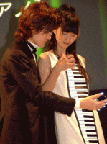
You're Playing Me!
When I saw this "hand roll piano" with a MIDI interface at King's Idea Shop in Shinjuku earlier this year, I just thought it was a neat idea. But, Professor Tsukamoto of Kobe University and his team had a much wilder idea about the use of similar flexible piano devices. They came up with this idea of a wearable piano, showed it off at a wearable computing fashion show in Japan last year, and presented a paper about it at a conference last month.
Someone says a next step of this could be a wearable orchestra with many other wearable musical instruments. I'd think of it more like a tool for participative improvisation jam sessions. Related: Paper Piano; Wearable Halfkeyboard. [blogged by manekineko on we-make-money-not]
Posted by jo at 03:36 PM | Comments (0)
October 02, 2005
FlirtSkirt
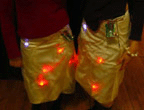
Clothing as Palette
FlirtSkirt by MICHAL BRIL and SONALI SRIDHAR: Explorations in wearable technologies began with our interest in arbitrary social interactions among people in public spaces. Instances of interaction seem to occur through body langauge, common interests and common brands. Some of our observations led us to see that the i-pod, when new in the market, called for the silent nod when you passed another person with white ear buds. Walking dogs are almost an instantaneous conversation starter, and people who might otherwise come from disconnected lives start a conversation on the same frequency. This struck us as a good starting point for our piece.
User A wears her skirt and turns it on and her skirt holds the colours that have been initialized. On reaching a particular distance from user B the outfits start communicating with each other. They recognize the initial colors, mix them and display the shared color on both outfits. In addition when in range the outfits dim. When user A and B have separated from each other and moved beyond the range of frequency, they leave with the shared color ready for interactions with new users.
Posted by jo at 09:56 AM | Comments (0)
September 27, 2005
Digital Peacock Tails
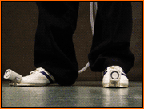
Designing Post-Optimal Electronic Attire
Although digital technology is becoming increasingly personal and intimate, electronic artefacts and systems are often conceived of as tools, designed to support goal-oriented tasks and activities as efficiently as possible. The Digital Peacock Tails project looks beyond this narrow point of view and employs digital technologies not only as efficient tools but also as beautifully challenging plumages.
The Siren Shoes make a loud noise when both feet are on the ground at the same time. The wearer faces the dilemma of either altering her gait or becoming a shrieking public nuisance.
The Miscalculator is a software application that produces a result close to the truth but not always. When installed, the Miscalculator permanently removes and replaces the standard Windows calculator. Conceived as digital tattoo, it probes electronic expressions based on permanence and sacrifice of control.
The SMS Headband allows people to send text messages to the wearer's forehead. It explores social and psychological costs and the loss of control (of the expression of a prominent part of the body canvas.)
The Backstabber replays fragments of conversations recorded several hours ago. The wearer turns into a spy, a leakage between different times, and a security breach, but also a source of interesting secrets. How does it feel to wear other people's secrets as personal adornments, and how does it affect the interaction with others? Read more >> [PDF]
Posted by jo at 12:49 PM | Comments (0)
September 26, 2005
The Art, Technology, and Culture Colloquium of UC Berkeley's Center for New Media Presents:

Ephemeral Gumboots: Dancing the Rhythm of Change
Ephemeral Gumboots: Dancing the Rhythm of Change by Cobi van Tonder, Artist and Musician, Johannesburg; *Wed*, 28 Sept, 7:30-9pm: UC Berkeley, 160 Kroeber Hall. All ATC Lectures are free and open to the public.
The history of Gumboot dance illustrates the potential of culture for transforming social aggression. Cobi will present Ephemeral Gumboots, a hybrid media artwork/musical instrument that takes South African Gumboot dance and extends it as an interface into an electronic music-making system. How does the music of Ephemeral Gumboots reflect the media age in South Africa? How has the artist or facilitator, responded (or succumbed) to the politics and hegemony of technology?
For Deleuze and Guattari, music "both simulates space and creates it literally, on the dance floor, in headphones, on the Internet" (Andrew Murphy, 2000). The refrains of dance music provide territories for the body and mind to move and travel. Cobi will reflect on the contemporary impact of technology and her personal experience of it as she presents her project from a socio and political perspective. She will also invite composers and dancers to use her system for further creative exploration.
Cobi van Tonder, aka OTOPLASMA, is a South African composer, producer and performer who specialises in interactive electronic music and other digital media. She has worked with various dance choreographers, video artists and actors. She also produces commercially for cinema, television, radio and mobile media. Cobi van Tonder holds a degree in Music in History and Society ( University Of The Witwatersrand ) ; a National Diploma in Light Music (Technikon Pretoria) and a National Certificate in Musical Theatre (Technikon Pretoria). She was born in Pretoria and grew up in a small town in the North Western countryside of South Africa. During 2005, she is ZERO ONE/IDEO artist-in-residence in the Bay Area.
For more information see >>
ATC Primary Sponsors: UC Berkeley Center for New Media (CNM) and Center for Information Technology in the Interest of Society (CITRIS) .
Additional ATC Sponsors: Office of the Executive Vice Chancellor and Provost, College of Engineering Interdisciplinary Studies Program, Consortium for the Arts, BAM/PFA, and the Townsend Center for the Humanities.
ATC Director: Ken Goldberg
ATC Associate Director: Greg Niemeyer
ATC Assistant: Irene Chien
Curated with ATC Advisory Board
For updated information, please see >>
Posted by jo at 06:00 PM | Comments (0)
September 22, 2005
How-To: Embed a wifi detector into a backpack strap
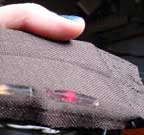
Integrated WiFi Sniffing
"Do you have a messenger bag or backpack you use regularly? Do you have a laptop or other device with wifi in said bag? Wouldn’t it be cool to integrate wifi sniffing into your bag and not have yet another device on your keychain? Today we will show you how to take an existing inexpensive passive wifi detector and embed it into the strap of your messenger bag or backpack.
Creativity is the key with this hack! If you have basic soldering and sewing skills, you can finish this mod easily in an afternoon. A flickr stream with annotations for this project is located here. Images with flickr annotations are clickable (i.e. if the image is associated with the flickr stream it will link to to it)." Continue reading at engadget.com.
Posted by jo at 06:53 AM | Comments (0)
September 15, 2005
TECHSTYLE NEWS

Issue #53 - September 15, 2005 [excerpts]
Techstyle News is a free monthly newsletter providing summaries and commentaries on stories related to the next generation of mobile technology and style, produced by Thinking Materials.
APPLE UNVEILS NEW WEARABLE MP3 PLAYER: Apple has introduced the iPod nano, a completely new iPod that’s thinner than a standard #2 pencil and weighs only 1.5 ounces. The iPod mini replacement is available in 2GB ($199) and 4GB ($249) capacities in either white or black designs. The ultra-compact device features a high-resolution color screen, Click Wheel, and offers up to 14 hours of battery life. Apple has announced several new accessories for the device, which the company calls the “most fashionable and wearable iPod ever.” The new gear includes lanyard headphones, which integrate the headphone cables into the lanyard; armbands in five colors, including gray, pink, blue, red and green; a set of silicone “Tubes” in five colors, including pink, purple, blue, green and clear; and dock.
PHILIPS SHOWS PHOTONIC TEXTILES: Philips Research has shown prototypes of its photonic textiles—fabrics that contain lighting systems and can therefore serve as displays. The researchers have managed to integrate flexible arrays of multicolored LEDs into fabrics without compromising the softness of the cloth. The LED substrates are also capable of displaying Windows Media Player-style visualisations and feature responsive sensors so that the patterns of diffused light displayed can change according to how they are handled.
SIRIUS ANNOUNCES NEW WEARABLE MUSIC PLAYER: Sirius Satellite Radio has unveiled its first wearable music player. The new device includes enough storage capacity for up to 50 hours of recorded Sirius content or audio files. Unlike XM's portable device, MyFi, Sirius's product will not be able to receive satellite signals on the go. Rather, it must be plugged into a docking station. The move comes as satellite radio players try to expand from the auto market. Both Sirius and XM have online streaming music services and "plug and play" devices that let users hook up to Sirius both in their cars and in their homes.
RESEARCHERS CREATE POWER BACKPACK: Scientists at the University of Pennsylvania have developed a backpack that can actually generate electricity as its wearer walks. The suspended-load backpack can generate about seven watts of power solely via the motion of the person carrying it, which is achieved by detaching the pack’s frame from the load it carries and harnessing the energy generated as the load moves up and down on vertical springs. The actual energy generated depends on the weight of the load and how fast the person walks, but is usually enough to charge several handheld devices at the same time. The pack is reportedly comfortable to wear, and doesn’t weigh significantly more than a conventional pack.
EVENTS
ISMAR 2005 IN VIENNA: Mixed Reality and Augmented Reality are highly interdisciplinary fields involving signal processing, computer vision, computer graphics, user interfaces, human factors, wearable computing, mobile computing, computer networks, distributed computing, information access, information visualization, and hardware design for new displays and sensors. MR/AR concepts are applicable to a wide range of applications. The International Symposium on Mixed and Augmented Reality, ISMAR, is the premier forum in this field and will be held in Vienna on October 5-8.
WICON AMERICAS IN SANTA CLARA: Wireless Connectivity (WiCon) Americas, to be held in Santa Clara on October 5-6, is the one stop shop for wireless connectivity solutions in the US. It's a high-level conference and exhibition to address leading wireless technologies such as Bluetooth, NFC, UWB, Wi-Fi, WiMax and ZigBee and the huge potential of the wireless networking applications they enable. The conference will focus on the convergence and co-existence of these technologies and their integration into mobile and computing devices. In addition the show will highlight some of the real life applications of these technologies in key vertical markets.
SIGDOC 2005 IN COVENTRY: SIGDOC 2005, to be held in Coventry on September 21-23, will provide an opportunity for the exchange of information related to exciting new research and empirical results in areas such as documenting mobile, pervasive and component-based systems, information design for delivery in a pervasive-computing environment, design for new communication media, culture and communities communicating in a pervasive environment, gathering and presenting information from pervasive computing networks and usability of information in a pervasive environment.
MOBILE HCI 2005 IN SALZBURG: MobileHCI provides a forum for academics and practitioners to discuss the challenges, potential solutions and innovations towards effective interaction with mobile systems and services. It covers the analysis, design, evaluation and application of human-computer interaction techniques and approaches for all mobile computing devices and services. The conference will be held in Salzburg on September 19-22.
CEATEC JAPAN 2005 IN TOKYO: CEATEC JAPAN is the largest international exhibition in Asia for the technology and electronics sectors, including the fields of imaging, information, and communications. Experience all the recent trends in IT and electronics, from technologies that showcase futuristic lifestyles to products that will be on store shelves during the upcoming winter season, including several new wearable devices. The fair is held in Tokyo on October 4-8.
Posted by jo at 11:05 AM | Comments (0)
September 06, 2005
WatchMe
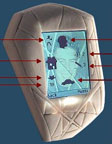
Communication Between Closely-Knit Group
WatchMe, by Natalia Marmasse, and Chris Schmandt, will be a platform for mobile communication and awareness, in the form of a watch, which addresses these limitations.
WatchMe enhances communication for a subset of people with whom we want an open channel of rich communication and for whom we want to be available. These are typically people from our "inner circle" with whom we have an established relationship, some common grounding, and a basis of trust. By sharing personal context information with our "insiders" we can enhance the instances of non co-located communication, and by providing channels of non-verbal communication we can foster more (verbal or non-verbal) communication and increase the existing sense of connectedness. The approach is to provide insiders with updated remote awareness information.
This mutual awareness serves two different purposes. First, it can strengthen the sense of presence of people we care about and may encourage further communication, besides being a form of non-verbal communication in itself. Second, it will provide insiders trying to contact us with enough information to make an informed decision regarding our availability and the most appropriate communication medium.
This project addresses mobile communication and awareness of people in a closely-knit group. It aims to enhance the telecommunication between them by providing relevant telepresence and a mobile platform facilitating various channels of verbal and non-verbal communication. Related: RealPlayer Movie; MPG Movie; UbiComp Paper (pdf).
Posted by jo at 10:08 AM | Comments (0)
Ars Electronica
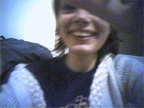
Regine Blogs Ars
TEMPEST is based on the surveillance technology known as Van Eck Phreaking - computer screen content can be reconstructed remotely by picking up the emitted EM-field of the screen. TEMPEST utilizes this technique to transform purely generative graphic into a composition of noise which again is fed back into the image generating process. Several AM receivers are tuned into different frequencies of a screen and plugged into an audio mixer for further sound processing. The graphics on the screen become a means of producing sound and it is only the graphics which determine the different timbres and rhythms. By Erich Berger.
Interface Culture at the Linz University of Art was founded last year by Christa Sommerer and Laurent Mignonneau. The programme deals with human-machine interaction to develop innovative interfaces. Went to see their works yesterday.
SoundToy, by Christina Heidecker, Harald Moser and Timm Oliver Wilks, is a 3D environment you navigate as if you were a racing car driver. During the ride you use the steering wheel to create and compose 3D sounds. You place in the space sound objects assigned to electronic beats. The speed, pitch and volume can be individually adjusted using the steering wheel and the accelerating pedal. The composition is generated by the movement and position of the sound objects with respect to one another but also by the route you select.
Recipe Table, by Istvan Lorincz, Hanna Perner-Wilson, Thomas Wagner and Andreas Zingerle, is an interactive workplace built into a kitchen countertop that enable users to intuitively search for recipes. You place the tins and bottle, vegetable and other ingredients and in return the system makes you recipe suggestions. These culinary suggestions are also depicted graphically as finished dishes on the workplace.
Blow, by Taife Smetschka, is a breath-controlled video installation. There's a microphone and a projection of a clip from Billy Wilder’s film *The Seven Year Itch*, the scene in which Marilyn Monroe stands on the grate above the subway ventilation shaft. At first she is stationary, smiling at viewers from the screen. She doesn’t begin moving until she feels a cool breeze. In *blow!* the breeze has to be provided by the installation visitors who must blow as hard as they can into the microphone. Marilyn’s skirt flutters in the breeze as long as the visitor blows into the microphone.
Mika Satomi's Gutsie is a cyber android filled with “guts.” Peeping into its interior through its eye-like hole, you can observe its intestines in motion. It will show you the places you want to see by tracking your eye gaze, but at the same time, your gaze may infect it. The interior of our body is something very private, often disgusting, and thus prohibited to be seen or to be shown. In media, visual images of our insides are often used to induce feelings of violence or disgust. Ironically, this is something that is stuffed inside everyone’s body without exception.
The G-Player (Global player), by German artist Jens Brand, works like a CD-player. But instead of playing CDs, it plays the globe. The device knows the postion of more than a thousand satellites and enables you, by the use if a virtual 3D planetary model, to listen to an imaginary trace of a selected flying object. Like a needle on a record, the satellite follows the Earth's surface. The G-Player transforms the different elevations units course directly into sound. The simple display shows the selected satellite's name, type, altitude and position over the planet (thus the latitude and longitude). Topographic data are interpreted as audio data. "Noise sounds" result from the high density of the data. Pictures.
[via we-make-money-not]
Posted by jo at 08:45 AM | Comments (0)
September 05, 2005
Boots as Instruments
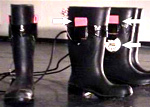
Cultural Gateway
Cobi van Tonder is a South African composer, producer and performer who specializes in interactive electronic music and other digital media.
Her interactive project Ephemeral Gumboots “uses sensor-equipped rubber boots to explore digital variations of a traditional South African dance form. This project was inspired by the desire to take historical or traditional art forms (in this case Gumboot Dance) and transform it into the Digital realm, creating a gateway between old and new and enabling dialogue between these two worlds.”
Ephemeral Gumboots is a human/computer-dance/music interactive system. Real-time rhythmical input from a dancer into a program ‘humanises' electronic beat-driven music while at the same time the dancer is exposed to a complex and diverse palette of prepared musical samples. The gumboots become musical instruments played by the dancer.
She outlines the dance, musical implications and technical aspects. For a thorough discussion of the project and research read her thesis on Music Composition and Performance in Interactive Computer/Human Systems.
Posted by michelle at 05:05 PM | Comments (0)
September 01, 2005
Sonic Fabric 2
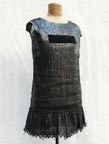
Sacred Sounds
Sonic Fabric is Brooklyn-based artist Alyce Santoro's venture that weaves textiles from recycled audio cassette tapes recorded with sounds she considers sacred. The fabric emits a melange of sound when swiped with the head from a tape player and can double as a musical instrument, like when Jon Fishman of Phish wore Santoro's "Sonic Rhythm Dress" and gloves fitted with tape heads in concert. Partly inspired by Tibetan Buddhist prayer flags printed with blessings activated by blowing winds, Santoro sells silkscreened flags, an over-the-shoulder Monk/Messenger bag, swatches, and flags made with the custom sound collage from Fishman's dress on the Sonic Fabric site. You can peruse her other work, including the Silence Dress (pictured above), which is "black sonic fabric with black velvet patch of silence" on her personal site. In the future, look out for sonic fabric handbags that she's currently having produced at a women's craft co-op in Nepal. [blogged by Ami Kealoha on Cool Hunting] [Related]
Posted by jo at 09:25 AM | Comments (0)
August 29, 2005
A Public Fashion Orchestra
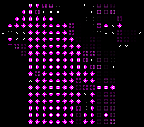
Network Revealed
Temporary networks (ad-hoc wireless networks) are designed to be "visible" to devices only, not to people. Without consulting our devices, we can't tell whether this minute we are participating in a network or not, and we are not asked whether we want to either.
Public Fashion Orchestra--by Alexandra Von Feldmann (with Stuart Wood)-- combines the conservative "wearable" network (e.g. networked wireless enabled mobiles) with an alternative, truly "wearable" and visible network.
The project envisions a fashion house which would sell intelligent clothes and their behaviours. All the clothes are networked with each other and when in range they can share designs and eventually other data; the fashion designer is able to feed new designs and behaviours into the system.
The clothes receive, transmit, transform and show the data, but they can also remember and limit it: once the clothes are "full", they cannot participate in the network anymore unless you get rid of their data with the brush of a hand.
While dressing up, the wearer can activate the clothes. As soon as he/she encounters another fashion network member, communication between the two is triggered by an RFID-Tag embedded into their garments. Once communication is established, data is being transmitted by the devices carried by the users (e.g. wireless enabled mobiles). [blogged by Regine on we-make-money-not]
Posted by jo at 11:56 AM | Comments (0)
August 23, 2005
[-empyre-] clothing [and/as] technology

Clothing as Interface
From: Empyre/Felix Sattler
Sent: Sunday, August 21, 2005 8:24 PM
Subject: [-empyre-] clothing [and/as] technology
hi Heidi, Katherine Moriwaki, Floyd & empyreans,
just a few quick and maybe too loosely connected thoughts on wearables, clothing and technology. at the same time as the whole debate about the fusion of clothing with technology (high fashion colliding with high technology, etc...) is fascinating, it unfortunately is likely to cover its own cultural history.
in the past, clothing had not been enhanced by [digital] technology but itself had been rather synonymous with technology. together with the development of language the use of materials to cover the human body (i.e. the naked animal life) had been the primary cultural operation by which man (indeed physically) established a border between himself and the animal world, hence becoming human at all.
interestingly enough, the german word for this "border" between the naked body and the environment "grenzflaeche" (grenze=border, flaeche=surface) translates as "interface" in english, which makes the quality of clothing-as-technology quite apparent.
from this point of view, it becomes obvious that clothing/wearables fulfill several cultural tasks at the same time which even seemingly contradict each other. their function as a cover/shield/border for/of the human body "seamlessly" interacts with the one as a means of communicating/ exposing the body to the outside world. fashion has largely understood this ambivalence (being the original concept of an interface) for a long time and basically works on this principle.
the idea that wearable technology is something that is rather hidden while at the same time used to communicate with the outside world is therefore found at the beginning of the development of wearable computers. claude shannon and ed thorpe developed the first wearable computer in 1961-66 in order to "predict" roulette wheels, i.e. cheat casinos in las vegas. the computer (that was later famously labelled the "eudaemonic shoe computer" after the group of MIT-students called the "eudaemonics") was a small device hidden in the sole of a shoe. it was controlled by the movement of the toes and its feedback consisted of acoustic information via an almost invisible headphone connection.
anyway, before going too much into technical detail (i'm always trying to avoid that, but you can check out the links below for more info) i'd rather stop here.
i guess when we are dealing with wearable computer technology and especially with those that is able to establish [physical] connections between users we should be aware that clothing is way more than just a second skin (in fact it is (culturally) entirely different from skin and never a mere skin-extension). performing/transmitting data/language/touch/etc... through clothing as an interface therefore should imply a sense for the cultural function clothing inherits from the past.
best
felix
links to the history of wearable computing/MIT-shoe comp:
http://en.wikipedia.org/wiki/Wearable_computer
http://www.media.mit.edu/wearables/lizzy/timeline.html#1966a
http://wearcam.org/historical/node2.html
http://physics.ucsc.edu/people/eudaemons/layout.html
http://www.eyetap.org/wearcam/eudaemonic/
Felix Sattler Research Project: *Mapping the Casino - A Curatorial Adventure Into The Postindustrial Paradigmatic* Faculty of Media Bauhaus University Weimar Ernst-Kohl-Str. 2 D-99423 Weimar Germany phone: +49-3643-815968 mobile: +49-160-4155881
Posted by jo at 05:04 PM | Comments (0)
August 19, 2005
Embrace
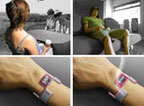
Seamlessly Connected
Embrace--by Lisa Thomas and Jonathan Fitch--is a concept bracelet that enables the user to be seamlessly connected to their significant other over periods of separation. It consists of five nodes: an LCD screen displaying images sent via Bluetooth; battery; technical components that fuel this device; a camera lens that constantly records images until the user specifically shoots an image by gently grasping each side of the lens node, which uses "touch sensitive" technology; and a scent palette that emits one of five odors chosen by the owner of the device indicating an incoming image from their significant other.
For example, when you receive the scent of pina-coloda, others may be able to smell it as well, but only you will really know why it smells like pina-coloda. The shape of Embrace allows the bracelets to unite with one another. Related: Fragrance delivery brooch set, Digital fragrances. [blogged by Regine on we-make-money-not]
Posted by jo at 10:51 AM | Comments (0)
August 16, 2005
TECHSTYLE NEWS: Issue #52 - August 15, 2005

Next Generation Mobile Technology
Techstyle News is a free monthly newsletter providing summaries and commentaries on stories related to the next generation of mobile technology and style, produced by Thinking Materials.
In this issue: (1) Hardwear News: Motorola and Oakley announce cellphone sunglasses; Texas Instruments launches mobile single-chip solution; MP3 sunglasses from Global American Technologies; Digital locket from Beatsounds; Digital picture pendant from Spectare; (2) Softwear News: IBM software lets you carry your PC around your neck; and (3) Events: Mobicom 2005 in Cologne; Ubicomp 2005 in Tokyo; Wearable Futures in Newport.
HARDWEAR NEWS
MOTOROLA AND OAKLEY ANNOUNCE CELLPHONE SUNGLASSES
Motorola and Oakley has announced the expected availability of RAZRWIRE Bluetooth eyewear in early August. The Bluetooth module is designed to complement the overall look of the sunglasses, creating truly wearable technology. The controls include two volume buttons and a single button used to handle incoming and outgoing calls. RAZRWIRE allows you to carry on phone conversations while up to 30 feet away from your compatible Bluetooth-enabled cell phone. Bluetooth Sniff Mode technology increases the battery life of RAZRWIRE, offering continuous talk time of more than five hours and standby time of up to approximately 100 hours.
http://oakley.com/about/razrwire/
TEXAS INSTRUMENTS LAUNCHES MOBILE SINGLE-CHIP SOLUTION
TEXAS Instruments has announced the launch of its single-chip mobile solution. Manufacturers such as Nokia, Motorola, and Ericsson are expected to launch handsets based on the solution in nine months. Mr Tom Engibous, Chairman, said: "The single-chip solution will bring down power and space consumption by 50 per cent and cut costs by 30 per cent". With this, he said, there is the possibility of $20 cell phones on the horizon. The small chips can be easily integrated, bringing phone technology to all kinds of products.
http://news.com.com/Is+a+20+cell+phone+on+the+horizon/2100-1039_3-5823239.html
MP3 SUNGLASSES FROM GLOBAL AMERICAN TECHNOLOGIES
Global American Technologies have launched the Fio MP3 sunglasses. The retail prices are $200 to $400 at storage capacities of 128MB up to 1GB, include 3D stereo sound earbuds in each arm, support MP3/WMA/ADCPM and have a reported battery life of 8.5 hours. Transfer is via USB 2.0 to either a Mac or a PC, with an integrated microphone providing digital voice recording capabilities.
http://www.techtree.com/techtree/jsp/article.jsp?article_id=5284&cat_id=505
DIGITAL LOCKET FROM BEATSOUNDS
The Digital Locket EMP-Z II Plus from BeatSounds tries to be more than just a wearable MP3 player. This tiny music player has a small, oval color screen that can display a photo. The Digital Locket measures 2 inches by 1.8 inches, weighs 0.9 ounce and has a battery that lasts up to 16 hours before it needs recharging. It can play digital audio files in the MP3 or Windows Media audio formats and comes with its own software for transferring photos and music from a computer over a USB connection. An FM radio tuner and a voice recorder are also tucked inside. Prices start at $80 for the 256-megabyte version and go up to $150 for the model with a full gigabyte of memory.
http://beatsounds.com/Pb/index.asp?CurrentCatID=C1035889862578133
DIGITAL PICTURE PENDANT FROM SPECTARE
The Pixi Digital Picture Pendant is a necklace with a 1-inch, 96 x 64 pixel LCD screen and enough memory (512 KB) for storing up to 54 extremely low-res digital photos. For viewing up to 2 hours in slideshow mode, or longer in manual mode. The pendant is USB 1.1 compatible and compatible with photos in JPEG format.
http://chipchick.blogs.com/chip_chick/2005/08/pixi_digital_pi.html
SOFTWEAR NEWS
IBM SOFTWARE LETS YOU CARRY YOUR PC AROUND YOUR NECK
Researchers at IBM are testing software that would let you tote your home or office desktop around on an iPod or similar portable/wearable device so that you could run it on any PC. The virtual computer user environment setup is called SoulPad, and consumers install it from a x86-based home or office PC. SoulPad uses a USB or FireWire connection to access the network cards for connecting to the Internet, the computer's display, the keyboard, the main processor and the memory, but not the hard disk. After the person disconnects the system, SoulPad saves all work to the device, including browser cookies or other digital signatures that a PC keeps in its short-term memory.
http://www.research.ibm.com/WearableComputing/SoulPad/soulpad.html
EVENTS
MOBICOM 2005 IN COLOGNE
ACM MobiCom 2005 is dedicated to addressing the challenges in the areas of mobile computing and networking. This single-track conference serves as an international forum addressing networks, systems, algorithms, and applications that support the symbiosis of mobile computers and wireless networks. It will be held August 28 through September 2 in Cologne. Speakers include representatives from Bell Labs, Daimler Chrysler, NTT DoCoMo and MIT. Particularly interesting could be the panel on Wearable computing with, among others, Steve Mann.
http://www.sigmobile.org/mobicom/2005/
UBICOMP 2005 IN TOKYO
UbiComp 2005, the Seventh International Conference on Ubiquitous Computing, will be held September 11-14, 2005 in Tokyo. The conference provides a forum in which to present research results in all areas relating to the design, implementation, application and evaluation of ubiquitous computing technologies. Papers include submissions from Intel, NTT, Nokia, Microsoft and IBM. There are also thirteen workshops to participate in.
http://ubicomp.org/ubicomp2005/
WEARABLE FUTURES IN NEWPORT
Wearable Futures is an interdisciplinary conference, to be held in Newport on 14-16 September, which aims to bring together practitioners, inventors, and theorists in the field of soft technology and wearables including those concerned with fashion, textiles, sportswear, interaction design, media and live arts, medical textiles, wellness, perception and psychology, IPR, polymer science, nanotechnology, military, and other relevant research strands. We will be examining how some broad generic questions will be explored in relation to wearable technology including but not restricted to: aesthetics and design, function and durability versus market forces; the desires, needs and realities of wearable technologies; technology and culture; simplicity and sustainability; design for wearability.
http://artschool.newport.ac.uk/smartclothes/wearablefutures.html
Posted by jo at 09:57 AM | Comments (0)
August 09, 2005
Super-i®
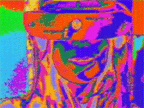
Real Virtuality™ System
Super-i® is made for those who want to see the world differently, - painted in fresh new colors. With Super-i® you'll be fascinated by what you see: the world as you know it will be looking absolutely different. Our goggles are equipped with the brand-new system of Real Virtuality™, which changes "real" world around us into a virtual one, and does it without a computer and in real time!
With our product you will not have to spend time sticking to your monitor and stressing your eyes; you will not have to wait long until the system boots up; you will not be unhappy with the image quality anymore! And, most importantly: with Super-i® you will finally reach unimaginable level of freedom - freedom to physically move around in the space in any direction, indoors or outdoors!
How does it work?
The heart of Super-i® is a microchip developed by our company on the basis of the newest technologies. It allows real-time (without delay) processing of a video signal and applying different effects on it. Other system components are: a video camera with a "human" angle of view, and a pair of excellent image quality micro-displays. The whole system is assembled inside a lightweight goggles that comfortably fits any head. The unit is absolutely autonomous and is powered by standard AA batteries, which can run it for few hours.
Effective algorithms, similar to those used in professional systems of image processing (such as Adobe Photoshop™) are embedded into Super-i®. The quality of the camera and micro-displays is so great, that not only you'll be able to explore the wonderfully altered reality, but also to get around easily. [via]
Posted by jo at 06:55 AM | Comments (0)
August 06, 2005
The Company Keeper
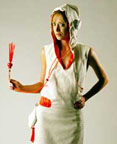
Systematic Self-Awareness
The Company Keeper--by Sara Diamond, Di Mainstone, & The Am-I-Able Design Team--acts as a virtual friend to amuse, comfort, and support its wearer with audio playback and to neutralize the occupant's nervous disposition. The wearer's mood is assessed by his/her body language (calculated with embedded touch sensors and an accelerometer in a hanging beaded tassel) and the level of sound in the environment. When moods such as wrath, awkwardness, and claustrophobia are detected, an antidotal soundscape is played through headphones in the hood. Via Wired. [blogged by Regine on we-make-money-not]
Posted by jo at 07:14 AM | Comments (0)
August 01, 2005
HyperSense Complex
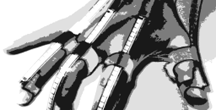
Exploring Ways of Interacting with the Computer
HyperSense Complex--the collaborative trio of Alistair Riddell, Somaya Langley, and Simon Burton--have been working together since 2002. They've been exploring the notions of collaborative interactive performance in a networked computing space (essentially where members of the trio - dependant on configurations of specific performances - can influence each other's sound, for example: by sampling each other's output, adding effects etc). HyperSense has also been developing an alternative HCI's using flex sensors worn on the hands (and strapped into a jacket arrangement). The project utilises data sent from the sensors through microcontrollers and passed via USB to some python scripting which handles what the sensor data should do. They then implemented OSC and are using this to send information to SuperCollider running on a separate laptop, which handles the samples and audiobased materials.
Posted by jo at 08:31 AM | Comments (0)
August on -empyre- soft-skinned space:

Wearable Technologies
This month on -empyre-, we venture into the world of wearable technologies in the context of social and public art practice. Katherine Moriwaki (US) is an artist and researcher investigating clothing accessories as the active conduit through which people create network relationships in public space. Florian 'Floyd' Mueller (AU) designs interfaces that deliberately require intense physical effort to facilitate social connectedness between remote participants. Heidi Kumao's (US) incisive feminist practice currently investigates the RFID tags that industry is adopting for product tracking, the government for border control and public libraries for automatic checkout.
Katherine Moriwaki is an artist and researcher investigating clothing and accessories as the active conduit through which people create network relationships in public space. After receiving her Masters degree from the Interactive Telecommunications Program at New York University's Tisch School of the Arts, Katherine co-developed and taught the ground-breaking collaboration studio "Fashionable Technology" at Parsons School of Design. Currently a Ph.D. Candidate in the Networks and Telecommunications Research Group at Trinity College Dublin, her work has appeared in IEEE Spectrum Magazine, and numerous festivals and conferences including numer.02 at Centre Georges Pompidou (02), Break 2.2 (03), Ubicomp (03,04), eculture fair (03), Transmediale (04), CHI (04), ISEA (04), Ars Electronica (04), Wired NextFest (05), and Siggraph (05). She is a 2004 recipient of the Araneum Prize from the Spanish Ministry for Science and Technology and Fundacion ARCO.
Florian 'Floyd' Mueller is a Principal Scientist in the ICT Centre, leading the "Connecting People" group at CSIRO - Commonwealth Scientific and Industrial Research Organisation, Australia. His research interests are in novel interfaces that help people to connect, to media as well as to other people, creating a more seamless connection between humans and technology. He proposed the concept of Exertion Interfaces: interfaces that deliberately require intense physical effort to facilitate social connectedness between remote participants at
Heidi Kumao is an artist who dissects ordinary social interactions using new media and animation, kinetic/electronic sculpture, and performance art. Her work takes the form of intimate robotic/kinetic installations, single channel videos and animations, and wearable electronics. She uses technology to address feminist issues and insert a femal point of view into the world of high-tech innovation. "WiredWear" consists of the research, design, and creation of one-of-a-kind articles of women's clothing equipped with custom electronics and an accompanying informational video. Each article enhances the wearer's everyday life by transforming the smallest social interaction or relationship into a performative exchange or by providing the wearer with important vital information (words of encouragement, bio feedback, etc.). Kumao also works collaboratively with Preemptive Media, a group of artists, activists, and technologists to create projects around emerging technologies and their corresponding policies such as RFID (Radio Frequency Identification). Their most recent project, Zapped!, investigates the RFID tags that industry is adopting for product tracking, the government for border control and public libraries for automatic checkout.
Posted by jo at 07:08 AM | Comments (0)
July 26, 2005
The Underbelt
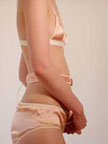
The Stay Slim "Tug"
The Underbelt--by Cristina Bilsland--is a piece of underwear. This self-operated constricting device provides a physical reminder of satiety whenever required. As soon as a button is pressed, the belt pulls itself inwards, giving the wearer a brief "tug" around the waist to give the body a physical reminder of satiety. It then releases to a comfortable fitted position. This piece challenges our awareness of guilt towards gluttony through physical constriction. Science has proven that tightness around the waist plays a major role in our behaviour towards food consumption. Ironically, clothing manufacturers continue to silently and gradually increase actual fitting dimensions whilst continuing to use existing size labels. This piece raises the question whether we are subliminally buying into this self-delusion. It also aims to question how far we are prepared to go in our indulgent quick-fix culture. [for entire "Fat" post see we-make-money-not]
Posted by jo at 07:05 AM | Comments (0)
July 22, 2005
Mollycoddle

Reciprocal Relationships
With Mollycoddle, Christine Liu wanted to explore the relationship that people have with their clothes. Mollycoddle is a dress with a hunger for love and attention. Its wearer needs the dress for obvious (coverage) or nonobvious (personal) reasons, and in turn, the dress needs the wearer. Mollycoddle wants to be touched and caressed by the wearer on a semi-regular basis, but it can be happy being touched by other people, too.
The dress is sort of an externalisation of the wearer's need for affection and attention. If the dress doesnt get touched or hugged in a while, it gets lonely, and the same goes for the wearer.
If the dress doesnt get loved enough, it gets needier and starts squeezing the wearer, begging for a touch or two. It will send vibrations as well. First it's a little huggy-plead which gets more aggressive with time. If its begging is ignored the thing will squeeze you to, ostensibly, death.
Christine Liu explained that "the touch part works, the squeeze part is still ongoing. i would like to have a corset-like frame in there to do that, but for the current prototype i have some naggy pager motors in there for vibrations along the kidneys and a tie-around necklace with its ends connected to some motors for squeezes around the neck. i didnt want to kill anyone in the construction of this thing, so i'm treading carefully." [blogged by Regine on we-make-money-not]
Posted by jo at 07:06 AM | Comments (0)
July 14, 2005
GOLDWIN

Jacket with Built-In Sound System
If you are the sort of user that doesn't like using headsets then this new jacket might be the kind of product you are looking for. Japanese company Goldwin has announced a series of products with built-in amplifier and a flat panel speaker system. The series includes different models of snowboard jackets and a backpack. Prices vary from US$300 for the backpack to US$625 for one of the jackets.
Users can connect any flash memory or hard disc based mp3 player, CD player or other sound source through a stereo jack. The sound output is through flat panel speakers which the company says provide high directivity with clear sound. The fact that the sound mixes with the background noise is an advantage according to the company, making it more "natural". The system also supports mobile phones through a built-in microphone. There is also a remote control available. The products should be in the Japanese market by end of July 2005. [via Techstyle News]
Posted by jo at 12:25 PM | Comments (0)
July 09, 2005
StalkShow

Navigating the Isolation of Others
StalkShow--by Karen Lancel and Hermen Maat--deals with threat of unsafety and isolation in public spaces. The performer carries a backpack, containing a laptop with a touch screen. It is a wearable billboard, with an attached webcam that records the face of the user of the touch screen.
Passersby are invited to touch the screen and navigate through statements about insecurity and isolation. The statements were written by asylum seekers, nuns, prisoners, digipersonas and others who live an isolated life. The user can identify her/himself with one of these persons and navigate through his/her statements. The navigation is displayed by a video projection on a large screen located in the same space (train stations, museums, squares, airports, etc.) The projection shows the portrait of the person that is using the touchscreen, together with the statements superimposed over the portrait. The user "watches" through a technically created, social-psychological frame of mind which seems to have a life of its own. [blogged by Regine on we-make-money-not]
Posted by jo at 12:27 PM | Comments (0)
July 08, 2005
m.pleasure
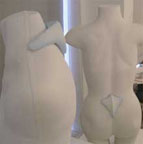
Feel the Communication
The mobile pleasure unit (m.pleasure) pushes forward the relationship we have with the mobile phone. m.pleasure works with a Bluetooth enabled phone. Attached to the most sensitive areas of our body, its intention is to translate an ethereal digital message into something physical, letting us feel the communication.
m.pleasure is also a critical approach to how we have sacrificed our personal relations for the benefit of technology: face-to-face relations are being pushed aside in favour of ever less physical communication.
As in every relationship, there will be a giver and a receiver. The Giver is totally safe, acting from their almost virtual position and sending messages to whomever they choose. The act of sending a message, however, becomes an altruist act of pleasing people.
The Receiver is placed in a completely complementary role. By connecting the m.pleasure to their body, they are rendered vulnerable and open to let technology act upon them. Receiving becomes an egotistical and carnal act of experiencing physical pleasure.
m.pleasure has been prototyped and the technology behind it already exists in the open market.
By Nagora Salaberria, at Someth;ng. [blogged by Regine on we-make-money-not]
Posted by jo at 02:12 PM | Comments (0)
June 24, 2005
Chanel TV Belt
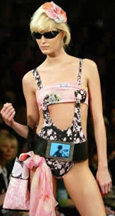
AttentiveTV
"Gadgets Gone Glamorous! None other than our beloved Karl Lagerfeld himself put his innovative mastermind to work to create this Chanel TV Belt. This gem was almost overlooked during this year’s Chanel Spring/Summer 2005 Runway Presentation, yet it is the item for any socialite this summer. Yeap, Karl is always good for some ridiculous magic out of the blue. And yes, the screens did indeed show Nicole Kidman’s ad while the models ran the catwalk. However, it is questionable that this gadget will ever hit the Chanel stores. A lady at the NYC store apparently mentioned it may stay runway only, but who knows with Chanel.
What more could this world need than more garnered attention and stares at peoples crotches? [blogged by Vlad on The Purse Blog] "...But what I love even more is the prospect of incorporating AttentiveTV (3.4MB .mpg) technology into the new Chanel TV Belt...Would it not be even more cheeky/mod if the Chanel TV Belt had the ability to know when someone was looking at it?..." [blogged by connor on HML]
Posted by jo at 02:43 PM | Comments (0)
June 20, 2005
Invisible Media
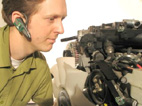
Sensing Focus
Invisible Media: David Merrill and Daniel Schultz are investigating the interaction possibilities that arise when objects in the environment and wearable computers can cooperatively sense the focus of a person's attention. Currently implemented with infrared transceivers, Invisible Media can sense the gaze of the user, while simultaneously communicating their identity. In a learning scenario this two-way ID passing and attention sensing can enable a stateful teaching interaction that tracks the progress of the learner. In a public setting, objects being attended to can transmit the URL of a relevant audio stream or other media to a mobile user. Exciting opportunities for collaborative filtering arise when the number of users and augmented objects gets large.
Posted by jo at 11:07 AM | Comments (0)
June 17, 2005
The Head

A Wearable Sculpture
The Head is a wearable sculpture with a connection to the internet and a public access via sms. The sculpture contains "an eye" (a camera lens) and a camera phone which captures images and sounds in certain intervals. People can send the Head sculpture an SMS to which the sculpture responds by capturing an image and recording a short soundfile. This image and the sound are sent back to the SMS-sender. They are also uploaded to a website with date and time of the capture accompanied with the sent sms-message.
The Head will be adopted and carried around by people and its "vision and hearing" is both automated and triggered by public to collect memories on the way. It will be also set (by the artist) to be adopted by people in professions which generally have "a view" on the society: police officer, politician, tourist guide, teacher, etc. Author: Laura Beloff (one of the developers of the Seven Mile Boots.) [blogged by Regine on near near future]
Posted by jo at 10:01 AM | Comments (0)
June 14, 2005
Storytelling Wearables: An Alternative Autobiography

Mobile Biography
Xiao Li Tan's Storytelling Wearables: An Alternative Autobiography explore storytelling and enable people to discover Xiao's relatives and birth city through looking at the movie bag, examining the shell necklace, and by lifting the hidden pieces on the skirt. The Portable Movie Bag shows images of Taishan in China. People can also learn about the stories of the artist's relatives by lifting some fabric on the Peekaboo Portrait Skirt, and they can experience her childhood memory of shells through the glowing Mood Shell Necklace. All the pieces are either powered by 3v battery, or self charged battery. They are portable and meant to be worn. More pictures. [blogged by Regine on near near future]
Posted by jo at 07:44 AM | Comments (0)
June 07, 2005
1000
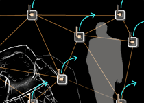
(little tips of communication)
1000--by Usman Haque with 5050 ltd--is a collaboration with wearable computing designer Despina Papadopoulos to develop a device and a system that account for technologically-aware bodies in technologically-animated spaces. The project incorporates current and near-future technologies like RFID, GPS, smart dust and smart fabrics to explore the relationship of technology, social bodies and environments. The purpose of the project is to explore actual usage of non-precious technology while at the same time challenging established traits of ubiquitous computing approaches.
In the past 10 years we have witnessed a series of projects that explore the relationship between technology and space or technology and the body. Yet few, if any, have attempted to align the two approaches and investigate the technological body in a technological space. The project synthesizes these two tracks of exploration and develops a system where both the "social body" and "space" are participating in an interactive dialogue.
Posted by jo at 11:39 AM | Comments (0)
June 03, 2005
Ange

Musical Ribcage
Ange, designed by Danielle Wilde, is a body mounted series of "ribs" with electronic sensors that enable a user to play different sounds, including breathy notes, a gong, rushing water, drums and an oboe. The notes respond differently to pressures. The idea is to use the body as an interface and allow the user to metaphorically touch and "play" the body of the wearer. The design is inspired by an 18th century engraving, Ange Anatomic by Jacques Fabien Gautier d’Agoty. [via near near future]
Posted by jo at 09:22 AM | Comments (0)
June 01, 2005
whiSpiral
![snow2.small[1].jpg](http://www.turbulence.org/blog/images/snow2.small[1].jpg)
Embedded Memories
whiSpiral is a spiral-shaped shawl that carries whispers of your loved ones and explores how technology can enhance the way garments and accessories evoke memories of these relationships. Circuitry integrated in the textile allows your friends to record audio messages at different points in a spiral-shaped shawl. These messages are whispered back each time you wrap the shawl around yourself, or by caressing different parts of the fabric.
Each of the 9 miniature audio recording modulescan store a 10 second message. The locations of the modules are made visible by exposing some of their electronic components on the exterior of the shawl, covered by a protective material resembling 3 white leaves. A microphone connector is denoted by a yellow leaf. The whispers are released when sensors located in each audio module detect a soft caress or wrapping movement. Developed by Elena Corchero and Stefan Agamanolis when working for the Human Connectedness Group at Media Lab Europe. [blogged by Regine on near near future]
Posted by jo at 07:01 AM | Comments (0)
May 30, 2005
Parsons School of Design: Design & Technology Thesis Exhibition
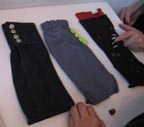
DT Saved My Soul
This past Wednesday was the opening for the Design & Technology Thesis Exhibition at the Parsons School of Design in New York City. The exhibit featured amazing thesis projects from both the MFA and BFA students in the department. It provides a chance to check out work and artists that have been mentioned elsewhere, such as Lina Fenequito’s Swap-O-Matic and fi5e’s Graffiti Analysis.
However it also provides an opportunity to check out new brilliant projects of those less known to the blog sphere media circuit. Discreet Interfaces, by Kaho Abe, explores the idea of wearable technology. By imbedding switches in the sleeves and hiding them with simple buttons or tags, the user can navigate the controls of a portable electronic device discretely without drawing any attention to themselves (well… other than that of someone who fidgets incessantly). Continue reading >> [blogged by Carol T. Chung on cool hunting]
Posted by jo at 12:37 PM | Comments (0)
May 19, 2005
Seamless
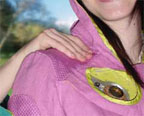
Computational Couture
If you're in the Cambridge, MA, area, don't miss the Seamless show to be held tomorrow. It will feature garments at the intersection of fashion and technology. "Some fashions are designed to cause people to examine the disconnect that many feel in the electronically augmented society," commented Nick Knouf who organised the event with Christine Liu. Among the works to be shown:
Simon Says: TOUCH, by Alison Lewis, is a wearable simon-like experience with integrated touch sensors which enable you to play on the back of your fellow man. With this shrug, you get simultaneous play time and a wonderful massage. She will also show her fabulous Closer pullover that respond to positive touch interactions.
Bea Camacho's Extensions are crocheted gloves and sleeve-like garments which embody the impulse to create connections with others but prevent any such interaction from taking place. They extend from the body but reinforce a sense of separation.
She also made untitled sound objects that make sounds when you squeeze them. The sounds were produced by systematically converting 2D shapes into sound waves. When squeezed, the objects become animated and seem as if they are trying to talk to you, as well as to each other.
The event will take place on May 20, 2005 at 8:00pm at the Media Laboratory, Cambridge, MA 02139. [blogged by Regine on near near future]
Posted by jo at 10:52 AM | Comments (0)
May 18, 2005
Technojewelry
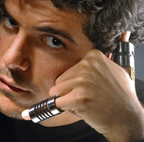
Let Your Fingers and Toes Do the Talking
Technojewelry incorporates emerging electronics into everyday attire. Focusing on the hands and feet as nonintrusive locations for useful innovations, these concepts prove that new devices needn’t look alien to your person and that we can make technology adapt to our lifestyles rather that the other way around.
Penta Phone and Ring Phone are concepts for mobile phones. The design takes its cue from the universal gesture for using a telephone, but is feasibly grounded in the nanotechnology research emerging from start-ups and established companies. Calls can be initiated by raising the hand to the proper position, and voice-activated interaction will allow instant communication. The little-finger units will vibrate to indicate incoming calls and the thumb unit will beam the sound towards the ear when the hand is held in the listening position.
Using similar low-power, nano-derived technology, GPS Toes are toe rings that communicate to a GPS receiver kept in a purse or worn on a belt. Wearing one on each foot, the GPS Toes device will guide the wearer to a preset destination by vibrating and lighting up to signal upcoming direction changes. The left toe ring will indicate left turns and the right toe right turns, whether driving on the highway, walking on city streets, or hiking on the mountain trail.
Also read The Experience of Enchantment in Human-Computer Interaction by John McCarthy et al. [via pasta and vinegar]
Posted by jo at 10:37 AM | Comments (0)
May 17, 2005
Haptic Gloves

Touching Sounds
The Haptic Gloves allow their wearers to create musical compositions by linking hands together. Each participant wears the gloves, headphones (through which they can hear their personal music) and a clip-on box housing circuits. As soon as they touch the gloved hand of another, they can hear their own music mixed with the other person's sound. The more people holding hands, the more sophisticated the track.
The interaction through physical touch attempts to physically bring people together even if they don't speak the same language. The Haptic Gloves are a work in progress by Kaho Abe and Jung Sin. Video on the website. More sound gloves: Saturday, Remote VJ control. [blogged by Regine on near near future]
Posted by jo at 10:32 AM | Comments (0)
Sonic Fabric
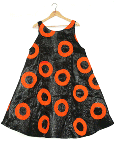
Playable Dress
Sonic Fabric--by Alyce Santoro--is made of textile woven from 50% pre-recorded audiotape and 50% cotton. Originally designed as a piece of conceptual art that would merely be looked at, it was discovered that the audiotape retained its magnetism throughout the weaving process, and the fabric could actually be "played" by running a tape head over it.
A custom dress made for Phish percussionist Jon Fishman was worn and "played" live on stage using specialized tape head gloves during a concert in april 2004. Pictures from designboom. [blogged by Regine on near near future]
Posted by jo at 10:24 AM | Comments (1)
May 09, 2005
MDCN Symposium
![MDCN_eflyer[s].gif](http://www.turbulence.org/blog/images/MDCN_eflyer[s].gif)
Art on the Move in Montreal
The MDCN Symposium featured presentations on the following MDCN projects:
Global Heart Rate: Project Lead/Chef de projet : Sara Diamond; Project Participants/Participants au projet : Tom Donaldson, David Gauthier, Anita Johnston, Geoff Lillemon--Global Heart Rate is a large-scale game experience for players and learners in specific urban and natural outdoor environments. It will eventually be networked over distance and amongst time zones. The current version takes place in Banff National Park. These participant-driven mobile experiences are both fun and informative, utilizing the structure of a game todisseminate interactive knowledge about a particular topic, such as Banff's wealth of natural history. Technically, these experiences include real-time synchronous and asynchronous processes, allowing immediate and/or thoughtful response.
Players use mobile telephones and a wearabletechnology component that enters information from sensor data. A rich, information-sharing experience for participants is enhanced by Global Heart Rate's use of micro movies, blue tooth networking, GPS mapping and data caching. Other research outcomes include a mobile gaming authoring system and iterative engineering/content methodology. Mimichi and the Flower Throw games are developed using participatory design methods.
Digital Cities: Project Lead/Chef de projet : Michael Longford & Kajin Goh; Project Participants/Participants au projet : Amitava Biswas, Daniel Lemay, Bita Mahdaviani, Antoine Morris, Rongxin Zhang
Digital Cities presents a locative media project designed for Parc Émilie-Gamelin using sound, image and GPS (Global Positioning System) sensors. An exploration of the urban environment as a wireless ecology, the project looks at the ways in which memory is inscribed in space, drawing on field recordings, oral history, and archival material to form a deeply-layered spatio-temporal mediascape. The viewer's orientation in space shapes the nature of their audio-visual experience. As they move through the site, different media events attached to GPS coordinates are triggered, ranging from sound (heard through headsets) to images and micro-movies (displayed on a handheld PDA). This project repositions our relationship within space and information flows somewhere between the public and the private, the material and the immaterial, and the virtual and the real.
CitySpeak: Project Lead/Chef de projet : Jason Lewis; Project Participants/Participants au projet : David Bouchard, Zehuan Liu, Bruno Nadeau, Alexander Taler, Frank Tsonis
CitySpeak is an investigation of how data acquired from an urban environment’s virtual networks can be used to investigate the same urban space’s physical environment. Using the Île sans fil hotspots in Montréal, CitySpeak selects several locations in the city that are rich nodes of both virtual and real-world traffic, and samples the geo-encoded data related to these particular locations. The dynamic qualities of the data are processed using a database called Next Text to construct ‘texts’ that interpret the data and determine how the texts will be represented visually. The resulting stream of text is layered back onto the locations using both very intimate (PDAs) and very public (large-scale projections) technology.
Mobile Cartographic Command Centre (MC3): Project Lead/Chef de projet : Marc Tuters & Karlis Otto Kalnins; Project Participants/Participants au projet : Jesse Cizauskas, Luke Moloney, Jaanis Garancs, Adrian Sinclair, Gabe Sawhney
Advances in peer-to-peer technology are changing how we connect to the internet as well as to each other, bringing about the idea of a niche-driven Commons. This installation presents the research of the MC3 mobile media lab, an art-led technology development project that explores concepts around unlicensed wireless communication, and civic engagement in the Canadian context. Housed within a modular field-research unit, the installation functions as a forward command post for map interpretation, digital piracy, and civic surveillance via an airborne remote visualization system.
Policy Report: Project Lead/Chef de projet: Barbara Crow; Project Participants/Participants au projet : Candice D'Souza, Ganaele Langlois, Samantha Moonsammy
The policy component of the MDCN project is reviewing and assessing the current status of national and international, industry, and social movement regulations of wireless communications in several countries. [blogged by tobias van veen on MDCN]
Posted by jo at 12:00 PM | Comments (0)
April 29, 2005
Psymbiote
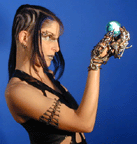
Hybrid Apparatus for Social Interface
Psymbiote is a cyborg performance persona by isa gordon in collaboration with Jesse Jarrell & DEvan Brown. Adorned in titanium, latex, silicone, and electronic apparatus, isa/Psymbiote places herself in the eye of the storm: the conceptual terrain at the collision of bodies and machines, the mutation of her own identity through transformation of the body. Ultimately the project seeks to fully transform the artist into a seductively organic yet entirely unfamiliar hybrid organism, a human/machine chimera with fully integrated control systems. The costume is being animated with movement, sound, and light; activated by manual triggers, automatic body processes, and remote control. As her evolution progresses, Psymbiote appears in public spaces to stimulate dialogue regarding the future of technological enhancements to the human body.
She has already been sighted at a number of universities, art shows, international conferences, and as host of the SIGGRAPH CyberFashion Show. The Psymbiote Project brings issues raised by the ongoing redefinition of our bodies into a public forum, highlighting some of the contemporary critical discourse surrounding cyborgs and all forms of human/technology integration.
Posted by jo at 07:43 AM | Comments (0)
April 27, 2005
The Hug Shirt

Soft Technological Sandwiches
F+R Hugs is a soft Lycra shirt with embedded sensors and electronics that allows to feel the physical closeness of a distant loved one, bringing the sensation of a hug. The system works through a mobile phone network. The shirts receive the input of heart beat, touch and body temperature of the remote loved one, recreating (through actuators embedded in the shirt) over distance the pulsation, physical pressure, and warmth of a real hug.
During the testing of the shirts, major intensity points were identified on upper arms, on the upper back part during a condolatory hug, around the waistline, neck, shoulders, and hips. In these strategic spots were placed soft technological sandwiches containing the hugging output actuators. Designed by Francesca Rosella - Ryan Genz, Cutecircuit; other works by Cutecircuits: Kinetic and cameleon garments. [blogged by Regine on near near future]
Posted by jo at 08:09 AM | Comments (1)
April 25, 2005
lifeClipper

The Walking Experience
lifeClipper is an open air art project. It offers an audiovisual walking experience in a virtually enhanced reality. Technically it is based on portable computer equipment worn by an individual. When walking around in a chosen culturally interesting area or impressive landscape the visitor's position and viewing direction is measured by means of GPS and the found situation augmented according to defined presets. Image and sound are displayed on an HMD (Head Mounted Display). Live captured image and sound are treated in real time by altering parameters as well as by adding music (composition, spoken text and sampling of documetary material), photo and video material (documentary and fictively arranged).
Through interventions on habitual ways of listening and seeing, reality becomes questioned and day-to-day situations become an adventure. Users feel as though they are watching a film in which they participate as active observers and in which they get attention from virtual players. The borders between subjective and objective perception become blurred as the user is immersed into space and action but also contemplates artistic compositions and cultural reflections. Read a review.
Posted by jo at 09:28 AM | Comments (0)
April 20, 2005
InterPlay: Loose Minds in a Box
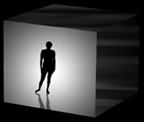
Six by Six
InterPlay: Loose Minds in a Box is a collaborative work that explores the basic concept of the "box". The box is a metaphor for the physical, social, political or psychological constraints that we and/or others place upon us. The box also represents a sense of place in the realm of the virtual as well as in our sub-conscience. InterPlay is a multi-faceted telematic event that consists of six simultaneous performances that occur in six states throughout North America. The performances incorporate theater, text, music, performance art, virtual reality, and motion capture and are concurrently captured, mixed, digitized, encoded and streamed onto the network.
Posted by jo at 08:42 AM | Comments (0)
April 19, 2005
Mogame + IPerG

Body and Game Controller
"One of the central features in the future will no doubt be networked play. Most traditional games are inherently social, and a mobile gaming device with network access provides opportunities for social gaming virtually anywhere, anytime. The possibilities for new game mechanics, taking advantage of the full range of contextual information provided by pervasive systems, expand the research and design space further. This is one of the major research directions being explored by some ongoing projects in the Tampere GameLab. This is also where new approaches to Huizinga's bounded 'magic circle' of game playing are tried out and investigated." From The City Shaman Dances With Virtual Wolves–Researching Pervasive Mobile Gaming by Frans Mäyrä, Receiver #12.
Posted by jo at 11:24 AM | Comments (0)
April 01, 2005
Power Pilgrims
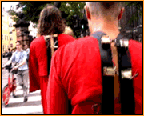
Electricity Keeps the World Together
The Amber pilgrims roam in and outside the exhibition space, ritually charging themselves with power. They rely on the generosity of others to share their 220V AC outlets. The pilgrims wear only the traditional Amber Robes. The robes are made of several pieces of fabric held together by recycled electro-magnets. The magnets are powered by a battery, fitted in a brazen container attached to the robe. Using the umbilical power cord the pilgrim recharges the battery from a normal wall socket. Without power the electro-magnets cease to function and the robe fall to the ground in pieces, leaving the pilgrim naked, ashamed and repentant.
The Power Pilgrims performance--by Unsworn--is a powerful illustration of how the meltage of man and machine always implies surrendering some control to larger technical structures. Wearing the Amber Robe produces a strong feeling of dependency. The experience makes the pilgrim intimately aware of the power outlet geography of her surroundings and the fragile nature of her identity. [via personaldebris]
Posted by jo at 03:41 PM | Comments (0)
March 08, 2005
VibroBod

Creating Visceral Personal and Social Interactions in Mediated Spaces
VibroBod [PDF] allows two users to communicate feeling; hand gestures and vocalizations made by one user convey emotional content to the other user. VibroBods rest on the laps of individuals having personal conversations via phone, chat or instant messaging, to amplify moods or tones that may otherwise be lost. The design intent was to facilitate awareness, empathy, and emotional influence across mediated channels. (…) In informal critiques with fifteen students and faculty, we found that the VibroBod indeed provoked strong reactions. At first, people were hesitant to place their fingers in the holes and were alarmed by the vibrations. As users learned how their actions were affecting the VibroBods’ behavior, they became very involved and attentive in experiential discovery and in trying to evoke particular vibration patterns that seemed like accurate representations of how they were feeling. [blogged by Nicolas on pasta and vinegar]
Posted by jo at 11:01 AM | Comments (0)
March 07, 2005
Wearable Futures:
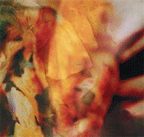
Hybrid Culture in the Design and Development of Soft Technology
SECOND CALL FOR PAPERS: Deadline for Abstracts: 14th March 2005
An event organised by Smart Clothes Wearable Technology Research Group, University of Wales, Newport and PDR, University of Wales Institute Cardiff in association with SCAN (Southern Collaborative Arts Network); 14 - 16 September 2005, University of Wales, Newport, WALES, UK.
Keynotes: Suzanne Lee, Senior Research Fellow at Central Saint Martins, Fashion, Consultant and author of Fashioning the Future pub Thames and Hudson Sept 2005; Joanna Berzowska, Artist and Assistant Professor of Design and Computation Arts at Concordia University in Montreal; Sarah E. Braddock Clarke, Lecturer, Curator and Writer. Co Author of Techno Textiles, SportsTech and Techno Textiles2 pub 2005; Chris Baber University of Birmingham, Reader in Interactive Systems.
This two day International conference will aim to contextualise the future potential of Wearable Technologies in a variety of fields ranging from military application to fine art.
Wearable Futures is an interdisciplinary conference, which aims to bring together practitioners, inventors, and theorists in the field of soft technology and wearables including those concerned with fashion, textiles, sportswear, interaction design, media and live arts, medical textiles, wellness, perception and psychology, IPR, polymer science, nanotechnology, military, and other relevant research strands.
We will be examining how some broad generic questions will be explored in relation to wearable technology including but not restricted to: aesthetics and design, function and durability versus market forces; the desires, needs and realities of wearable technologies; technology and culture; simplicity and sustainability; design for wearability; wearables as theatre and wearables as emotional 'tools'.
Key fundamental questions across the conference in relation to wearables are:
What is out there?
Who wants it?
What do they want?
How is it achieved?
Please submit an abstract of no more than 400 words in a Word document format by: 14th March 2005 to: hannah.topping @ newport.ac.uk
For further information please refer to the conference website.
Abstracts and full papers will be peer reviewed and if accepted published in the Conference Proceedings. A selection from the full papers will also be considered for publication in a themed addition of the international journal 'A.I. & Society' (SPRINGER).
Abstracts may be offered as long papers (30 minutes includes questions), short papers (20 minutes includes questions) or for poster presentations. Poster presentations are particularly welcomed from postgraduate students.
NB: Please note final submission for full papers has been changed to 6th June 2005.
Committee currently includes:
Chris Baber, Reader, University of Birmingham
Joanna Berzowska, Assistant Professor, University in Montreal
Sarah E. Braddock Clarke, Author & Lecturer
Julia Cassim, Helen Hamlyn Research Centre, Royal College of Art
Andrew Chetty, Arts Consultant
Carole Collet, Director Textile Futures, Central Saint Martins College of Art and Design
Joan Farrer, Reader, Royal college of Art
Frances Geesin, Research Fellow, London College of Fashion
Rory Hamilton, Interactive Design, Royal college of Art
Jane Harris, Senior Research Fellow, Central Saint Martins College of Art and Design
Ros Hibbert, Textile Consultant
Suzanne Lee, Senior Research Fellow, Central Saint Martins College of Art and Design
Alan Lewis, Director of Research, University of Wales Institute Cardiff
Jane McCann, Researcher, University of Wales, Newport
Stephen Scrivener, Research Professor, Central Saint Martins College of Art and Design
Mick Siddons, Consultant, CR8ive Solutions Ltd
Helen Sloan, Director, SCAN
David Smith, Reader, University of Wales, Newport
Posted by jo at 04:53 PM | Comments (0)
March 04, 2005
2Wear

A Run Time for Adaptive and Extensible Wireless Wearables
"In the 2WEAR project we explore the concept of a personal system that is formed by putting together computing elements in an ad-hoc fashion using short-range radio. Certain elements are embedded into wearable objects, such as a wristwatch and small general-purpose compute/storage modules that can be attached to clothes or placed inside a wallet. Others have the form of more conventional portable computers, like PDAs and mobile phones. Also, there are stationary elements as part of the environment, some of which are visible, such as big screens and home appliances, while others are not directly perceivable by the user, such as network gateways and backend servers." [via del.icio.us/mlewis]
Posted by jo at 08:00 AM | Comments (0)
March 03, 2005
Framing the Ambiguous Wearable

The Undecidables
"Abstract: This article takes the concept of ambiguity as presented by Gaver, Beaver & Benford [1] as a tool to discuss what has been described as ‘undecidables' - conceptual art works in the domain of the wearable, which currently find themselves crossing the usual framing mechanisms of art, craft and design [2]. How practitioners choose to frame their work has implications for its interpretation. The physical object has a presence that can be hard to escape; it presents a reality already in existence, even as it suggests a possible future, and may even disallow the space between "looking at the work, and the prospect of using it" [3]. Some of the tactics used by conceptual practitioners in interaction design and contemporary craft to get around this problem are illustrated with a view to expanding the tactics for ambiguity offered by Gaver et al's original paper [1]." From Framing the Ambiguous Wearable by Sarah Kettley, Convivio Web-Zine, Issue 2. [blogged by Regine on 21f]
Posted by jo at 09:31 AM | Comments (0)
March 02, 2005
Joanna Berzowska

Second Skins
Joanna Berzowska was RISD's guest lecturer last night. She gave an impressive overview of both the 'wearables' field and of her own work. Amongst her many accomplishments, Berzowska is the founder of XS Labs (Extra-Soft Labs), "a design studio where we develop artifacts that are extra soft and react in weird ways to our bodies and our environments. We play, we experiment, we develop new technologies, we make art and we design products in the fields of physical computing, tangible media, electronic textiles and wearable computing." Their projects include Memory Rich Clothing, Inflatables/Deflatables, Animated Weavings, Addressable Textile Displays, Blazer:soundSleev and musical pants.
Wearables (also referred to as Electronic Textiles or Smart Fabrics) research is mostly funded and developed by the military, however there are many artists making "reactive clothes, second skins that can adapt to the environment and to the wearers, that can express aspects of their personalities, their needs and their desires, and represent aggregate social information."
Berzowska gave examples of other artists' work in the following three catgories: (1) Soundscapes, for example Saturday by Sabrina Raaf, and Sonic City; (2) Social Commentary, for example Lucy Orta's Refuge Wear and Medulla Intimata; and (3) Playful Garments, for example, Alison Lewis' Closer and Elise Co's Puddle Jumper. Berzowska stressed that practitioners need to consider why we want our garments to be electronic, and be mindful of their misuse (surveillance) as well as the environmental ramifications of mass producing such objects: "The killer app for wearable computing is to convey personal identity information. This is called fashion and it is mostly visual." (Berzowska). [Related]
Read ISEA Fashion (Wearable Computing) Report by Scott Rettberg.
Posted by jo at 03:57 PM | Comments (0)
February 15, 2005
Fair Witness

Wearable Escrow Video
Fair Witness by Rob Tow began with the question "...(W)hat is the structural inversion of television?" "Television is produced by someone else than the viewer; it comes on a set schedule; it is composed of many clips; it has high production values. The means of production are expensive, and centralized. Doing a structural inversion on these qualities lead to the idea of the short video clip, created by an individual, as a media type.
...A video camera has lots of controls, enabling fancy local recording, focusing, playback, etc. It also has local storage. What I came up with is the idea of a wearable camera, rather like a Star Trek communicator pin - which would be turned on when you slap it, and turned off when you slap it second a time...
Posted by jo at 08:01 AM | Comments (0)
February 14, 2005
Peau d'Âne
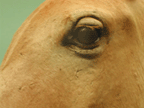
Locating Immaterial Materials
Peau d'Âne by Valérie Lamontagne: in the Charles Perrault fairy tale Peau d'Âne, a young princess, whose family's riches are dependent on a gold-excreting donkey, orders impossible wedding gifts from her father in order to avoid marrying him: three dresses made of immaterial materials. The first is to be made of the "sky" and should be as light and airy as the clouds. The second is to be made of "moonbeams" and should reflect the same lyrical intensity as the moon at night. The third, and last, is to be made of "sunlight" and should be as blinding and warm as the sun above.
Lamontagne will develop three wearables based on the Charles Perrault folk tale. Each dress--as a networked costume--aims to hybridize notions of computer interfacing and fashion. The "patterns" on the interactive material of the dress will morph according to information transmitted from a wireless weathervane to a computer chip implanted in the fabric. Utilizing wireless and solar-powered energy sources, Peau d'Âne goes beyond "making something out of nothing" and becomes a functional article marking another step in our aspiration to build truly ubiquitous objects.
InterAccess Electronic Media Arts Centre
Open Studio: February 19 - March 2, 2005
Work-in-progress Exhibition: March 4 - 24, 2005
Progress Presentations:
Saturday, February 19, 2005; 3 - 5pm
Saturday, February 26, 2005; 3 - 5pm
Valérie Lamontagne is a Montreal-based artist, freelance art critic and curator. She received her BFA (1993) and MFA (2001) from Concordia University (Montreal) where she is presently teaching in the Digital Image/Sound & Fine Arts program. Valérie has been exhibiting in and curating shows across Canada since 1997.
InterAccess is a centre for electronic media arts that enables artists and the general public to explore the intersections of art and technology. It is Ontario's only gallery and production facility devoted exclusively to electronic and new media art.
InterAccess Electronic Media Arts Centre
401 Richmond Street West, Suite 444
Toronto, Ontario, Canada
Gallery Hours: Tuesday - Saturday, noon - 5pm
Free Admission.
Related >>
Posted by jo at 10:56 AM | Comments (0)
February 02, 2005
On Haptics
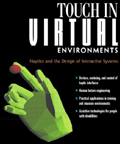
Extending Our Sense of Touch
"...That's how I learned that in ecological psychology, "haptic touch" is the name of the system that lets us feel stuff through objects we hold, to "feel the road through the stick or cane, or even through the wheels of a car we are driving." (Andy Clark) explained that, in this instance, "force and torque sensors buried in the arm" and other muscles are "activated the same way when we use a stick as when we touch with our hand." This is what allows humans (and a goodly number of our primate cousins—not to mention possibly raccoons and otters) to treat tools as if they were extensions of our bodies, extending our sense of touch through them." From Touching Your Own Future: Haptic Tools by Laurie Rowell. Also see Touch in Virtual Environments: Haptics and the Design of Interactive Systems
Posted by jo at 12:13 PM | Comments (0)
January 25, 2005
GoingPublik
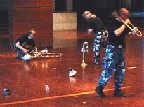
Mobile Multimedia as Mixed Reality
GoingPublik is a sound art work for distributive ensemble and mobile score synthesis. The core idea behind the work is a strategy of mobility by employing a wearable computer system running a software based electronic scoring system. GoingPublik will be performed at Interactive Futures 05 on February 5 from 9:30-10:30 pm. Art Clay will present a lecture "GoingPublik: Mobile Multimedia as Mixed Reality" from 2:30-3:30 PM.
"The core idea in the project is a strategy of mobility and this is accomplished employing a wearable computer system running the software based electronic scoring system as its central element. The program itself basically allows for what might be termed 'composed improvisation' which permits improvisational elements within a compositional structure. This is accomplished by electronically monitoring the performer's physical behaviour during performance. The program then responds by making suggestions to and even demands on the performer to various degrees and at various times.
Since each of the performers is equipped with the same electronic scoring system and because the system revolves around universally shared inputs such as geographical positions obtained via satellites and sensors using the earth's magnetic field, all have a common denominator and are thereby virtually linked. Despite the physical distribution of the performers in space, it is possible to have a commonly shared compositional palette and, at moments of close proximity between performers, to obtain instantaneous synchronized sonic elements. Both aspects needed for creating sonic structure within the work." Read paper >>
Composition Camouflaged: On the Relationship between Interpretation and Improvisation; Interview with Roland Dahinden, Günter Heinz & Thierry Madiot on the World Premiere of GoingPublik by Franziska Martinsen
Posted by jo at 10:05 AM | Comments (0)
January 22, 2005
Project Molly

Light Lunch with Molly
"Project Molly is a series of roaming interactive webcasts captured live using a wearable wireless audio/video acquisition system by artist Nichola Feldman-Kiss. Please interact with Project Molly live for light lunch and conversation via internet relay chat at the Project Molly interface."
Project Molly was a performance art/research innovation; it used a Xybernaut wearable computer with a head-mounted audio video acquisition and display system to stream a live video feed to the internet via wireless connection. The prototype real net video performances interactively linked the remote audience with the real time audience/performers via Project Molly’s personal a/v surveillance and chat interaction. Each consecutive interactive webcast incrementally evolved the project molly interface and knowledge database. Ultimately, the interface tracked project molly's movement through real space and captured streamed video into a data archive that is indexed and searchable by a variety of terms.
Posted by jo at 12:16 PM | Comments (0)
The Telepresence Garment
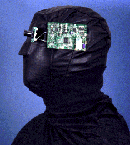
Engaged by Others, Remotely
"(Eduardo Kac) first conceived the Telepresence Garment in 1995 to investigate the notion of the mediascape as an expanded cloth; i.e., to consider wireless networking as a new fabric that envelops the body. The Garment, which I finished in 1996, gives continuation to my development of telepresence art. This time, however, instead of a robot hosting a human, we find the roboticized human body itself converted into a host. The Garment was designed as an interactive piece to be worn by any local participant willing to allow his or her body to be engaged by others remotely." Continue reading >>
Posted by jo at 12:10 PM | Comments (0)
January 20, 2005
the Electronic Guy
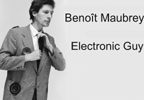
Performing Electro-Acoustic Clothes
Benoit Maubrey performs the Electronic Guy (guitar, sampler, electroacoustic Jacket, solar radio); Video In Studios, Vancouver February 14th, 8:00 PM; and Location 1, NYC, February 18th, 8:00 PM. Following the performance will be a video and slide presentation concerning Die Audio Gruppe.
Benoît Maubrey is the director of Die Audio Gruppe, a Berlin-based art group that builds electro-acoustic clothes and performs in them. Equipped with movement and light sensors, radio receivers, sound generators, samplers, amplifiers, loudspeakers - the clothes produce sounds by interacting with the environment and in response to the performers' movements (past examples: AUDIO BALLERINAS, AUDIO GEISHAS, AUDIO STEELWORKERS, BONG BOYS, AUDIO PEACOCKS...).
Stay tuned for Phonomaniacs (see web site): Maubrey's visit is the opening movement in a larger cooperative project between Die Audio Gruppe and local artists being planned for later this year. It will consist of a series of workshops followed by a sound event featuring 20-30 electro-acoustically costumed performers.
Posted by jo at 09:56 AM | Comments (0)
January 16, 2005
Suspending Disbelief
![im6[1].jpg](http://www.turbulence.org/blog/images/im6[1].jpg)
Stretching Conversations
Suspending Disbelief, by Anne Niemetz , is a performance in which four persons create music by stretching their suspenders. The suspenders have built-in bend sensors that trigger Larry King statements taken from his tv-show (King was known for his habit of "suspender-stretching.") The performers have the possibility to select, scratch and replay king's voice, in much the same way a dj can while playing records. The choice of sampled words and sentences lets the performers converse with each other about suspenders, showbusiness and the current social and political situation. (Posted by Régine Debatty)
Posted by Regine at 03:15 AM | Comments (0)
January 10, 2005
txOom
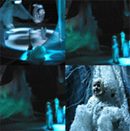
A PlaySpace made of wearable architectural elements
txOom is a responsive PlaySpace, where the participants are invited to actively take part in transforming the environment; shaping the sound, playing with visuals, tangling in textiles, and thereby influencing the audio and visual environment around them by the way they move and interact with the space. The txOom environments "adopt" the properties of living skins. Fabrics, garments and objects in these spaces are shapeable interfaces. [via near near future]
The PlaySpace is composed of several wearable architectural elements including wall-shirts, swing-dresses and floor-skirts. By wearing these garments, the participants literally wear the txOom space, causing the physical environment to be reshaped by their activity in it. This activity influences the shape of the physical environment as a whole, simultaneously inciting growth and mutation in the media worlds. Each player is sensed by the PlaySpace using motion sensors and vision tracking systems incorporated into the space. Gradually, the social interaction between the participants, and the responsive sound and visuals projected throughout the PlaySpace, will change and evolve as they begin to play together.
Posted by jo at 12:00 PM | Comments (0)
January 05, 2005
Habitgram

Cloaked in Space
Habitgram, by Montreal-based artist Beewoo, is a surveillance coat that the visitor is invited to wear. Inside the coat, several wireless mini-cameras pick up the environment of the wearer. The images are multiplied through video projections on the space walls. While wearing the Habitgram, the participant actually "wears" the space in which (s)he is standing.
As the cameras are positioned so as to rotate the captured images, either vertically, horizontally or at a 90° angle, some participants tried to restore the images to their original position and many others reported experiencing sensations of vertigo while wearing it.
"The user in command of this mediated image flow finds himself submerged in it in a discomforting way. Would the media image be so untamable? Drowning in this immersive environment, the viewer constantly attempts to understand its structure and source. Meanwhile, (s)he discovers new ways of exploring the physical architectural space in relation to its multiplied video mirror. Here, being immersed does not prevent the viewer from taking a critical distance towards the artwork. On the contrary, it is the immersion itself that triggers critical observation." [from near near future]
Posted by jo at 10:33 AM | Comments (0)
January 04, 2005
Saturday
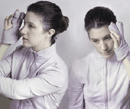
Sounds Mixed in the Bones of the Listener
"With the overuse of radio frequency bands for wireless communications, there comes the increased occurrence of crossed lines where a private conversation becomes accidentally shared. To create this interactive sound piece, Saturday, [Sabrina Raaf] used walkie talkies, CB radios, and various other forms of consumer spy (or ‘security’) technology in order to actively harvest such communication leaks. Saturday forms a uniquely intimate portrait of the community of Humboldt Park, Chicago through a composite presentation of conversations stolen on Saturdays in the park. Saturday is a sound based artwork that participants experience through a custom designed glove interface. [via near near future]
When I began working with wireless sound technology, I was startled by the sheer quantity of non-phone, low tech, radio transmissions that were constantly being sent around my neighborhood. Humboldt Park is a lower income, racially mixed neighborhood of Chicago. The transmissions included communications between gang members on street corners nearby and group conversations between friends talking about changes in the neighborhood and their families. There were raw, intimate conversations and often even late night sex talk between potential lovers. There is a furtive quality to most of these conversations and also a particular daringness in their tone. During the series of Saturdays, I also recorded the sounds of my neighborhood – the women singing out their windows to their radios, the young men in their low rider cars circling the block, the children, the ice cream carts, etc. These are the sounds that are mixed in the piece. And, these are the sounds that literally drip from participant’s fingertips in Saturday.
Saturday is presented in the form of an interactive glove. In order to hear the audio, participants magically just press their fingertips to their forehead and they hear the sound without the use of their ears. The glove is outfitted with leading edge audio electronic devices called “bone transducers” which make this possible. These transducers transmit sound in a very unusual fashion. They translate sound into vibration patterns which resonate through bone. This is the same process as the natural hammer and anvil system inside our inner ears which allows us to perceive sound. Since the bone transducer does all this work artificially, it allows you to hear crisp audio without it being played out loud or through headphones. So, even if a user covered their ears and then placed their fingers to their temples, they still ‘hear’ the sound. No sound at all is heard by anyone but the participant at any time. This piece permits a new way of listening. The user places their fingers to their forehead – in a gesture akin to Rodin’s The Thinker or of a clairvoyant – in order to tap into the lives of strangers. Pressing different combinations of fingers to the temple yield plural viewpoints and group conversations. These sounds are literally mixed in the bones of the listener."
Posted by jo at 07:50 AM | Comments (0)
January 03, 2005
LUCY ORTA

The Staging of a Social Bond
LUCY ORTA born in Great Britain 1966, studio based in Paris. Lucy Orta's Refuge Wear, was first noticed in the early 90's. These objects resembled temporary mobile architectures which transformed into poetic items of clothing, sleeping bags, first aid units, for nomadic populations. Her Collective Wear sculptures in the form of tent domes with protruding appendages, exhibited in the Modern Art museum in Paris in 1994 were placed into urban contexts for a series of interventions in housing estates, subway stations... and later developed into a human chain, Nexus Architecture which has since become the emblem of her work and has been presented in site specific performances such as the Venice Biennale in 1995, Johannesburg Biennale 1997, Museum of Contemporary Art Sydney 1998, Bolivia, Berlin, New York, Mexico City.
She encourgages in an active participation from very diverse members of the community by organising workshop "Actions" and her projects both in the museum space and within the community question the role of art as a agent for participation and dialogue. Particulary pertinent are the public works Life Nexus Village Fête co-comissioned by the University of Central England for the exhibition "In the Midst of Things" in Bournville 1999 and the Art Gallery of Western Australia 2000. Recent public works such as "Hortireycycling Enterprise" exhibited at the Secession in 1999 and 70x7 The Meal introduce the theme of the meal as a ritual for public exchange and at the Kunstraum Innsbruck in January 2000, she proposed a 70 metre table service with a series of lunches for infinite number of guests to dine together for a moment of convivialty.
"The staging of a social bond is the common denominator linking Lucy Orta's different projects and perfectly reflects her transverse approach to poetic expression. Her Refuge Wear and Nexus Architecture interventions are effective tools in the struggle against exclusion and combine architecture, body art, street theatre, fashion, social therapy, formal poetry and ideological activism. The titles of her principal projects, which function both as social scenarios and art works, speak for themselves : Nexus Architecture, Refuge Wear, Modular Architecture, Commune Communicate, Citizen Platform... She has, since 1992, brilliantly addressed issues of relational aesthetics, her principal field of intervention being the personal space of the individual fighting for survival in adverse conditions." Pierre Restany [thanks pasta and vinegar]
Posted by jo at 10:52 AM | Comments (0)
January 01, 2005
Go ahead, scream

Wearable body organs
ScreamBody is a "wearable body organ" by Kelly Dobson. The ScreamBody device permits wearers to indulge their impulse to scream, even in inappropriate places, by acting as a silencing vessel. The device also records your screams, and will play them back for you at a time that you determine.
This device cleverly exploits notions of appropriate behaviour and impulse. It is a whimsical device, providing a very specific purpose for public situations. It also comments on trends in device design, where some devices are incredibly specific (as ScreamBody is), contrasting with other devices that are meant to do everything except make your toast in the morning (such as some advanced PDAs), though they often are used for a singular feature that has the most relevant function. (Posted by Michelle Kasprzak)
Posted by at 04:09 PM | Comments (0)
December 27, 2004
netzwissenschaft
![]()
Emerging Infrastructures of All (Inter)net Research
Dr. Reinhold Grether's network research | netzwissenschaft site maps the "emerging infrastructures of all (inter)net research endeavours. net.science as an anthropology of connectivity is trying to overcome the constraints of specialist method transfers on net matters. the protuberance of technical networks necessitates a professionalization of human net knowledge. neither the isolation of concepts as in basic research nor the encapsulation of processes as in applied sciences will ever be able to adequately describe the complex autopoiesis of networks. net.science is undoubtedly developing into a scienza nuova of its own right."
Check out his Mobile Art and Virtual Performance research areas.
Posted by jo at 04:45 PM | Comments (0)
November 23, 2004
The Gambit
![]()
The Narrative Abilities of Flowers
The Gambit is a portable interactive animation sited in the lobby of the Westin-Bonaventure Hotel (John Portman, 1977). The medium of the project is a digital compass attached to a PDA ("personal digital assistant") with a two and a quarter inch by three and a quarter inch color screen and headphones. This apparatus worn by the viewer displays images of spaces normally inaccessible to the viewer's vision from within the Westin's lobby, in other words, as if you're seeing through walls with a kind of periscope.
The "seeing through the walls" has a shape, like Gordon Matta Clark's cuts through buildings. The shape is configured by animated still images and sound. The still images and sound tell a story. The story is of a hotel flower arranger, and of a parallel world where flower arrangements have archival and narrative abilities. The Gambit is a project of Kati Rubinyi.
Posted by jo at 09:45 AM | Comments (0)
November 07, 2004
body architectures
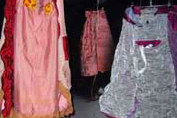
between bodies
is a wearable computing art project by Thecla Schiphorst and Susan Kozel. Their wearable body architectures were recently at the Roundhouse for Vancouver's New Forms Festival. These Sensing Skirts evolved from the Whisper project at Simon Fraser University.
"We use experience modeling to create gestural protocols for physiological data transfer. This design method has been applied to the development of a wearable computing public art installation called “whisper”.
A series of user-experience workshops were designed with the goal of developing an interaction model for the public installation. These workshops modeled intimacy, social navigation and playful exchange, using performance methods to create gestural protocols. Workshop participants generated movement vocabularies by negotiating permission and control of their own physiological data. Gesture was utilized as an expressive indicator of intentionality, extension of body image, permission, control, exchange and play.
We illustrate through video, gestural analysis, and experimental feedback, how the workshops provided an experience model for the interaction, wearable garment design, and body-to-body network protocol used in the public art installation, and how performance methodologies can contribute to the area of interaction design."
Posted by michelle at 03:11 PM | Comments (0)
October 28, 2004
The Click Sneaks
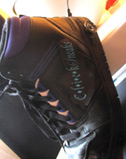
Tap for the Streets
New York designer and researcher Despina Papadopoulos, the founder of Studio 5050, had the idea for the Click Sneaks while walking down a cobblestone street, wearing sneakers next to a friend wearing stilettoes.
The artist recorded the "click" sound of high heels on a voice chip and had it activated on each step the revamped sneakers take. A speaker, an amplifier and a sensor acting as a "switch" on the sole of each foot, transform these seemingly normal sneakers into a sound performance.
Via Horizon Zero. originally from Popgadget: Personal Tech for Women, reBlogged by bev on btang reblog
Posted by jo at 09:07 AM | Comments (0)
October 21, 2004
Come Closer

The Edges of Personal Space
Continuing squidsoup’s explorations into immersive intuitive media and the boundaries between virtual and physical space, Come Closer uses wearable technology, wireless networking and stereo vision to explore and expand on our sense of personal space and proximity to others. The closer two people get to each other, the more acutely aware of each other’s presence they become. This sensation may be comforting or disquieting, but participants are encouraged to transcend the normal barriers of personal space and explore the meaning of closeness in both virtual and physical terms. The space between people is filled with sound that is affected by their movement and position. With more people in a room, complex harmonies begin to appear and disappear, allowing scope for cooperation and confrontation, intimacy and rejection.
Posted by jo at 05:45 PM | Comments (0)
September 24, 2004
Tripartite Interaction

Understanding Interaction in Ubiquitous Guerrilla Performances in Playful Arenas
"The inherent freedom of playful arenas with intimate ubiquitous technologies has led to a new breed of guerrilla performance. We draw on theory from computing, performance and club culture to illustrate the Performance Triad model, a method for the analysis, deconstruction and understanding of tripartite interaction in playful arenas. We then apply the Performance Triad to Schizophrenic Cyborg a part reversal of wearable computing technology where the user is outfitted with an electronic communication display and yet this display is visible to others not the cyborgs themselves. This ubiquitous performance investigates the shifting boundaries between performer, participant and observer and of technology-enhanced guerrilla performance." Read the paper by Jennifer G. Sheridan, Alan Dix, Simon Lock & Alice Bayliss.
Posted by jo at 06:15 PM | Comments (0)
September 07, 2004
UNSTABLELANDSCAPE

Dance and Mutable Media
"I envision the development of UNSTABLELANSCAPE beyond the local performance and gross movements of the dancers towards the use of autonomous streams of data, subtle measurement of biological functions (breathing, heart beat, earth movement, GP systems and distributed performance using the internet)...I would like to explore the augmentation of the system hybridicity and maximizing its bottom-up architecture with the integration of organic tissue such as neurons and muscle cells to the real time aspect of the video-sound-movement continuum (residency at Simbiotica, Australia). Later, I will expand the performance with this bio-digital generativity and with analog/biologically inspired robots. It is a continuation of the aesthetics of emergence."
marlon barrios solano
Posted by jo at 10:06 AM | Comments (1)
August 27, 2004
more for de feet
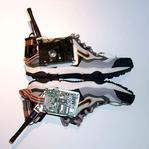
The Sensor Shoe
by John Paradiso
Ordinarily dancers dance to music. With the Sensor Shoe the dancer makes the music.
Electronic sensors are built into this ordinary shoe to pick up foot movement and changes in pressure. The short antenna at the back of the shoe transmits data from each sensor to a nearby computer. The computer is programmed with a set of rules that map the data to particular sounds. A digital music synthesizer produces the sounds, which are then heard through speakers.
See NY dancer Mark Haim dance in the sensor shoes (2001)
Posted by newradio at 09:59 AM | Comments (0)
magical footwear
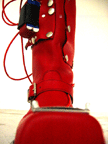
Seven Mile Boots
Seven Mile Boots,
"...the magical footwear known from folk tales that enables its owner to travel seven miles with one step. With little effort one can cross the countries, to be present wherever it seems suitable and to become a cosmopolitan flaneur with the world as the street."
The project Seven Mile Boots is a pair of interactive shoes with audio. One can wear the boots, walk around as a flaneur simultaneousy in the physical world and in the literal world of the internet. By walking in the physical world one may suddenly encounter a group of people chatting in real time in the virtual world. The chats are heard as a spoken text coming from the boots. Wherever you are with the boots, the physical and the virtual worlds merge...The site contains a short bibliography on the "flâneur."
Posted by newradio at 09:58 AM | Comments (0)
August 21, 2004
tell it all
Computer couture is all the rage these days. HorizonZero’s July issue focuses on "smart clothes" and "fashionable technologies." Banff’s Sara Diamond and Joanna Berzowska, Assistant Professor of Design and Digital Image/Sound at Concordia University, Canada, whose "Intimate Electronics" can be found in HorizonZero’s July issue are both at ISEA. We’re bound to hear more and more about the latest developments in this long history of prostheses, which probably had its beginning with efforts to improve eyesight. (Roger Bacon made the first recorded reference to lenses for optical purposes in 1268; in 1665, Robert Hooke called for inventions to improve our other senses. See A brief history of wearable computing. And we’ve been at it ever since.
But now it’s not the eyes but a pair of jackets that broadcast and respond to "their other half" by wireless signals. Yes, and make sounds like crickets mating when they find one another! Or, reactive garments that display their history of use. There’s high drama embedded in this stuff!
But also serious concerns.
While the recent exhibition DIS2004 in Cambridge, MA (USA), was not focused on clothing, it contained one wearable item in which concern was expressed for the overall impact of mobile communication: Fashion Victims by Italian artists Davide Agnelli, Dario Buzzini and Tal Drori. Mobile communication devices bring with them "a number of social consequences, most of which are still invisible, hard to map and to explain." In Fashion Victims the artists designed a collection of garments that react to surrounding mobile phone calls in order to make a part of the invisible visible. As more phone calls are conducted in their surroundings, the clothes "progressively and permanently change color." By producing a physical result they call attention to the "pervasiveness and intrusiveness" of the mobile phone – its tendency to "violate the private space we potentially have within the public context."
Another wearable, WiFisense (currently, a handbag with 64 LEDs embedded in the front) does something similar--it detects open wireless networks and uses patterns of light and sound to announce their availability, quality and accessibility.
Still, it seems far less likely to this blogger that cautionary clothing will find commercial support than clothing that extends the private into the public. It's the direction we Americans have opted for since radio and television first caught the public imagination.
And when in 2001 the Defense Advanced Research Projects Agency jump-started a project to accelerate the development of electronic textiles, one of its beneficiaries was MIT Media Lab graduate Maggie Orth, co-founder of International Fashion Machines (IFM) and someone taking clothing in that direction.
IFM’s proprietary electronic textiles include Electric Plaid, (color change textile technology) and StitchSwitch, (textile sensing technology). Combine them and you can create fully interactive textiles and artworks. Which means, among other things, you can change the color of your clothing or the interior of your house to match your mood. Read more
So I’d count on clothing that tells more and more about you. With your clothes giving you away, pretending may be hard .
Why we should be interested in this – and I think we should – will be the subject of another blog. And I'm hoping we can get some discussion going on it.
Posted by newradio at 12:35 PM | Comments (0)
August 20, 2004
Responsive video jewellery
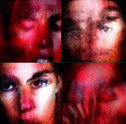
Capturing Neuroses
Medulla Intimata introduces a new form of non-verbal communicaton in the form of responsive video jewellery. Video displayed on a screen embedded in the jewellery is generated in real-time in response to the wearer's emotional state by monitoring the dynamics of conversations in which they are engaged.
Medulla Intimata explores social performance. Every interaction in a social setting starts as a performance of selves, a formal dance of introduction and a search for expression. Medulla Intimata provides a medium in which to visualise this informal social performance, allowing the interactors to monitor and feed off their mutual performance, and others to act as sporadic audience. Read more.
Posted by jo at 12:05 PM | Comments (0)
August 18, 2004
play that city

Sonic City
Sonic City, the artists write, is a project exploring mobile interaction and wearable technology for everyday music creation. We have designed, implemented and evaluated a system that creates electronic music based on sensing bodily and environmental factors. Mapping these to the real-time processing of concrete sounds, Sonic City generates a personal soundscape co-produced by physical movement, local activity, and urban ambiance. Encounters, events, architecture, (mis)behaviours – all become means of interacting with or 'playing the city'.
In this project, our intention is to break out of traditional contexts for music creation to explore creative possibilities within local surroundings and mundane activities. Wearing Sonic City, anyone can experience a simple walk down the street as an expressive act, a path through the city as a personal composition. As a complement to lived urban experience, it is an intimate soundscape intended to enhance perception and encourage new uses of the urban landscape.
Posted by newradio at 07:17 PM | Comments (0)
August 02, 2004
Mesh Performance Practices
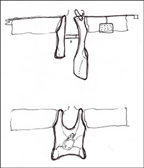
Exiles, Ghosts and Astronauts Physical interventions in the critique of virtual culture
Aura: Film Studies Journal, Volume IV, Issue 1, 1998, Susan Kozel
Exiles, Ghosts and Astronauts was a performance experiment occurring simultaneously between Riverside Studios and The Place Theatre in London (England). The videoconference link was made by Macintosh computers and basic internet videoconferencing software (CU-SeeMe). Performers in each location were projected into the other for a physical exploration of intimacy, weightlessness and altered materiality. It was part of Digital Dancing 1997, the London Dance Umbrella platform for dance and technology collaboration.
As physical exploration is undertaken, with telepresence and other forms of digital intervention in performance, the physical and philosophical vocabularies that emerge are mutually shaped and critical of one another. This article charts a course through philosophical debate and performance practice. Many voices and perspectives unfold across three sections: dialogue with Paul Virilio, devising process, and performance.
Continue reading at Mesh Performance Practices
whisper is a real-time interactive media installation based on small wearable devices, wireless computer communication, and handheld technologies embedded in evocative and playful garments worn by the participants. whisper intervenes aesthetically and critically in the evolution of our human environment by transforming the physical practices and technological interfaces that mediate our physical and emotional interchange. whisper is about creating new physical, technological, kinesthetic & affective vocabularies. whisper is a collaborative project involving artists (dance, sculpture, music), designers (of visuals, objects & textiles), computer scientists, and hardware/software engineers.
Posted by jo at 03:14 PM | Comments (0)

